


THE MAGAZINE OF THE MIZZOU ALUMNI ASSOCIATION mizzou.com | Spring 2024 M
Greening the Gateway Alumni cultivate a St. Louis parks renaissance Page 16
I ZZOU

FIRST LOOK
CAPTURING JUMPERS For one Saturday every October, hundreds of B.A.S.E. jumpers are legally permitted to take turns leaping from the New River Gorge Bridge in Fayetteville, West Virginia, and falling nearly 900 feet to the river below. Bridge Day, as it’s called, is not just an opportunity for thrill seekers. It also enables the Philadelphia-based photojournalist and commercial photographer Steve Boyle, BJ ’04, to experiment.
In 2022, Boyle, whose work has been published in ESPN the Magazine, Runner’s World, Bicycling and elsewhere, positioned his tripod in the New River on Bridge Day and shot images of each person descending toward him from the steel arch bridge. He then collaborated with digital artist George McCardle to create the composite image shown on the facing page.
“That day I was operating three cameras with focal lengths from 14mm to 1280mm and shot over 12,000 images,” Boyle says. He has covered the event sporadically over the years and has shot from various locations. One year he did portraits of each jumper. “I’ve photographed from the top of the bridge, the ground below the bridge and even from within the rescue boats in the water that pick up jumpers who wanted to take a dip,” he says.
Boyle has been making annual pilgrimages to the New River Gorge and Gauley River for two decades. It’s “a love that began while still at Mizzou,” he notes.
In October, Boyle hopes to photograph the jumpers from a walkway beneath the bridge.

1
FARMER not just a...
We are more than just farmers. we are...

To see all that we are, visit mosoy.org, or scan the QR code!

STewards
Leaders Scientists
M I ZZOU
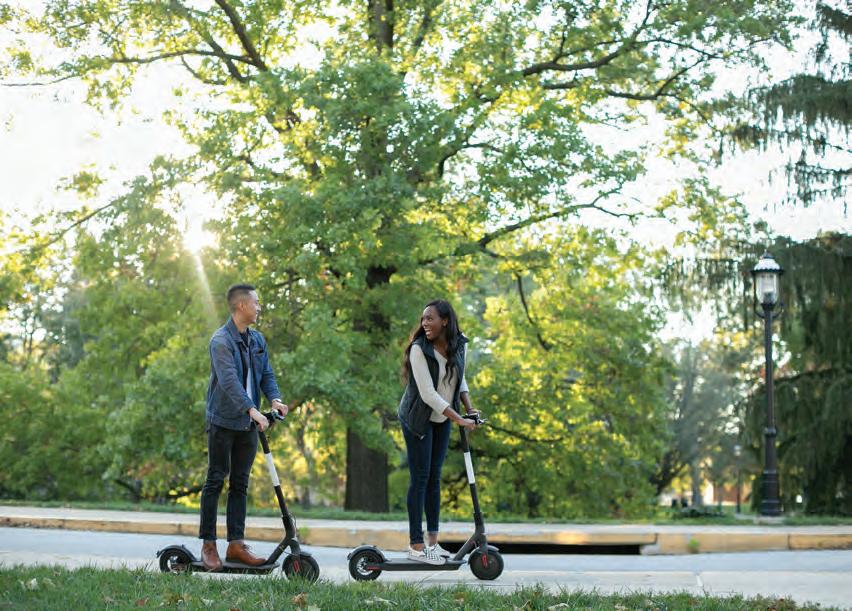
New Days Rising
If your memory’s foggy about springtime at Mizzou, you should know that it awakens and invigorates not just students groggy from nights cramming, calculating and researching. The whole of Columbia seems to stretch, rub its eyes and head outside to revel among the dogwoods and lilacs. Young MURR researchers sip single-pours while preparing to bombard alpha particles. Sorority and fraternity members wander in groups at sunset. Couples lounge on blankets in Peace Park and giggle at TikTok memes. The campus turns green, a transformation scored by so many joyous birdsongs and a bounty of seniors prepping for graduation.
Details have changed. Off-campus housing is thriving downtown. Walkers and cyclists now share bike lanes with future engineers rolling down Sixth Street on battery-powered onewheeled balance boards. Pizza Tree has better pies than Shakespeare’s. Electric scooters owned by Bird, more banged-up than in their pre-pandemic prime, ferry young MDs to and from the School of Medicine. The studied outcasts are back on roller skates, f.y.i. So many eBikes!
Among the many stories in this issue, we celebrate new growth with a feature on a quartet of greenspace-loving leaders who are running the St. Louis parks scene (and happen to be alumni).
Students roll through Peace Park on electric scooters.
School of Music professor-composer-pianist Brandon Boyd discusses his performances with the London Symphony Orchestra. And newly hired neuroscientist Smita Saxena, who recently relocated to Columbia from Bern, Switzerland, is changing the way we diagnose and understand the neurogenerative disease ALS.
As you’ll note on page 28, Mizzou’s recent successes include its highest-ever volume of applicants (for Fall ’24), an increase in retention and graduation rates, a record $462 million for research expenditures in fiscal year 2023 and a continued ascent in performance rankings among the research-focused Association of American Universities.
Those big numbers wouldn’t be possible without the dedication of individuals who wake up each spring (and summer, fall and winter) morning and commute to campus — whether by scooter, eBike, skateboard or plain old legs — to do the work.
RANDALL ROBERTS, BA ’88 Editor
Editorial and Advertising
Mizzou Alumni Association
123 Reynolds Alumni Center 704 Conley Avenue
Columbia, MO 65211
phone: 573-882-6611
mizzou@missouri.edu
Executive Editor
Erin Allen
Editor
Randall Roberts
Art Director Blake Dinsdale
Class Notes Editor
Jennifer Manning
Editors Emeriti
Karen Worley and Dale Smith
Advertising Scott Dahl: 573-882-2374
Mizzou Alumni Association
123 Reynolds Alumni Center Columbia, MO 65211
phone: 573-882-6611, fax: 573-882-5145
Executive Director, Publisher Todd A. McCubbin, M Ed ’95
Opinions expressed in this magazine do not necessarily reflect the official position of the University of Missouri or the Mizzou Alumni Association. ©2024
Statements of Purpose
The Mizzou Alumni Association proudly supports the best interests and traditions of Missouri’s flagship university and its alumni worldwide. Lifelong relationships are the foundation of our support. These relationships are enhanced through advocacy, communication and volunteerism.
MIZZOU magazine reports credible and engaging news about the University of Missouri community to a global audience.
BOARD OF DIRECTORS
President Mindy Mazur, BA ’99
President-elect Leigh Anne Taylor Knight, BS HES ’89; BS Ed 90; M Ed ’91 Immediate Past President Jeff Vogel, BS Acc ’90
Treasurer John Gamble, BS ’00
Secretary Todd McCubbin, M Ed ’95 Diversity and Inclusion Committee
Chair Vanessa Vaughn West, BA ’99
Directors Clarissa Cauthorn, BS ’15; Morgan Corder, BA ’18; Renita Duncan, BS Acc, M Acc ’08; Kevin Gibbens, BS BA ’81; Christine Holmes, BS BA ’10, MBA ’17; Matt Jenne, BS CiE ’97, MBA ’15; Cheryl Jordan, BA ’84; Emily Kueker, BS ’02; Stephen Neuman, BA ’98; Daniel Pierce, BA, BJ ’99; Amber Rowson, BS ME ’99; Martin Rucker, BS ’07; Mark Russell, BJ ’84; Nick Ruthmann, BS ’05, MD ’13; David Townsend, JD ’00; Kim Utlaut, BS ’89; Janet Wheatley, BS HE ’77
Student Representative Mathew Kimaku
MIZZOU magazine
Spring 2024, Volume 112, Number 3
Published triannually by the Mizzou Alumni Association
3 SPRING 2024
® ANNIKA MILLER
FROM THE EDITOR
TABLE OF CONTENTS
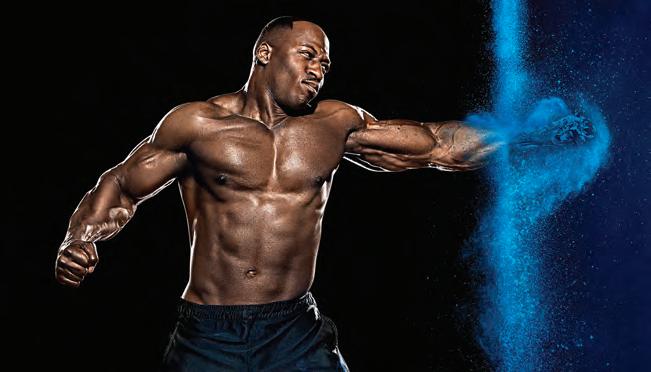
Steve Boyle Gallery In addition to B.A.S.E. jumpers (see First Look), photojournalist and commercial photographer Steve Boyle, BJ ’04, has captured images of bowhunters, solar eclipses, animal textures, boxers, Kentucky Derby races, classic Cuban cars and myriad other striking people, events and moments. For a gallery of photographs from the Philadelphia-based alumnus, visit mizzou.us/steveboyle.
CONTRIBUTORS
Departments
1 First Look
Photographer Steve Boyle, BJ ’04, captures an annual B.A.S.E. jumping event in Fayetteville, West Virginia.
6 Around the Columns
Springtime along the Mizzou Botanic Garden pathways; School of Medicine researchers have designed a molecule that might prevent certain cancers; Marching Mizzou visits Ireland and brings home gold and more
46 Mizzou Alumni News
A familiar Long Island TV anchor retires, celebrating the alum who called the legendary “Fifth-Down Game,” a St. Louis CEO (with a Super Bowl ring) works on solutions to the systemic problems of poverty and more.


Amanda Doyle, BJ ’94, is the author of nine books, including 100 Things to Do in Missouri Before You Die, Standing Up for Civil Rights in St. Louis and (with Steve Pick) St. Louis Sound: An Illustrated Timeline. Her most recent, with illustrator Dan Zettwoch, is Missouri Weird and Wonderful (Reedy Press). Doyle wrote this issue’s cover story, “Greening the Gateway.” Page 16.


Tony Rehagen, BA, BJ ’01, has written for GQ, The Columbia Journalism Review and Next Wave: America’s New Generation of Great Literary Journalists. He profiled former Mizzou football player and current Missouri State Representative Kurtis Gregory. Page 38.

About the cover


The work of Montreal-based illustrator Gérard DuBois has appeared in dozens of publications including The Wall Street Journal, The New Yorker and Le Monde. The artist, who has worked on more than 20 books for children and adults, was named 2022 Illustrator of the Year at the V&A Illustration Awards. Dubois illustrated “The Silent Intruder.” Page 32.


Chris Blose, MA ’04, is a freelance writer, editor, musician and amateur adventurer based in Bethesda, Md. He got his start on staff at MIZZOU magazine in the early 2000s. He founded and operates The Narrator, an editorial services company. Blose wrote about precision medicine in “The Silent Intruder.” Page 32.



facebook.com/mizzou
twitter.com/mizzou
instagram.com/mizzou @mizzou
48 Class Notes
Our alumni have succeeded in myriad ways across an array of disciplines, and we’ve got the latest on their successes, anniversaries, publications, passings, weddings and babies.
For this issue, Buenos Airesbased illustrator Iris de Luz created a digital collage based on landmarks, parks and greenspace in and around St. Louis. Of the images she uses, de Luz said, “I think of them as if they were part of a digital ecosystem where each element, when joined with others, builds a new character.” 64
Semper Mizzou
Seventy years ago, the baseball Tigers won the NCAA national championship. Among the players? Norm Stewart.

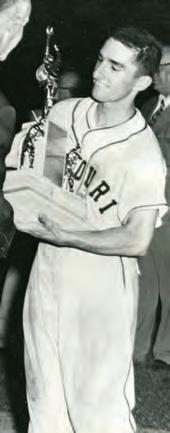
Council for Advancement & Support of Education Awards
2022: Bronze, Periodical/Magazine Design
2021: Gold, Feature Writing (“Who Was I in College?,” Winter 2020)
2020: Bronze, Feature Writing (“Forever Young,” Spring 2019) 2019: Bronze, General Interest Magazine

Society for Publication Designers Awards
2024 merit awards: “Vlad Has Stories,” Winter 2023; “The Cosmochemist’s Guide to the Galaxy” Spring 2023 2023 medal finalist: “A LIFE in Focus,” Spring 2022
2022 merit awards: “The Long Quiet,” Winter 2021; “International Reach,” Spring 2021; Spring 2021 cover 2021 merit awards: “Eli’s Calling,” Fall 2020; “A Third Act,” Spring 2020
4 MIZZOUMAGAZINE
M I ZZOU Greening the Gateway Alumni cultivate St. Louis parks renaissance Page 16
BOXER: STEVE BOYLE; BASEBALL: 1955 SAVITAR
MORE MIZZOU ONLINE

An illegal mining operation near the Homoxi region of the Yanomami Indigenous Land in the Amazon rainforest in Brazil. Mizzou researcher Rob Walker uses satellite imagery to better understand the plight of uncontacted tribes. Page 24.
Greening the Gateway
A quartet of St. Louis-area greenspace leaders have harnessed their Mizzou educations to steward the region’s most celebrated and enduring outdoor spaces. story by amanda doyle, bj ’94
24
The Silent Guardians of Lost Worlds
Using satellite imagery, Rob Walker explores the timeless lives of the Amazon’s isolated tribes. story by dale smith, bj ’88
Mizzou’s Winning Streak
Celebrating increases in research grants, enrollment, student success and more.
The Silent Intruder
NextGen Precision Health neuroscientist Smita Saxena explores ALS’s insidious path. story by chris blose, ma ’04 illustration by gérard dubois
Brandon Boyd’s Barbican Rhapsody
Since spring 2020, conductor, composer, pianist and School of Music professor Brandon Boyd has harnessed the powers of the London Symphony Orchestra and a chorus of 250 London voices at the Barbican Centre to perform Black spiritual music. story by randall roberts, ba ’88
Protect and Advance
Former Tiger offensive lineman Kurtis Gregory is blocking for his constituents — and student athletes — at the Missouri State Capitol. story by tony rehegan, ba, bj ’01
5 SPRING 2024 BRUNO KELLY/AMAZÔNIA REAL
32 36 38 28
16
Features
AROUND THE COLUMNS
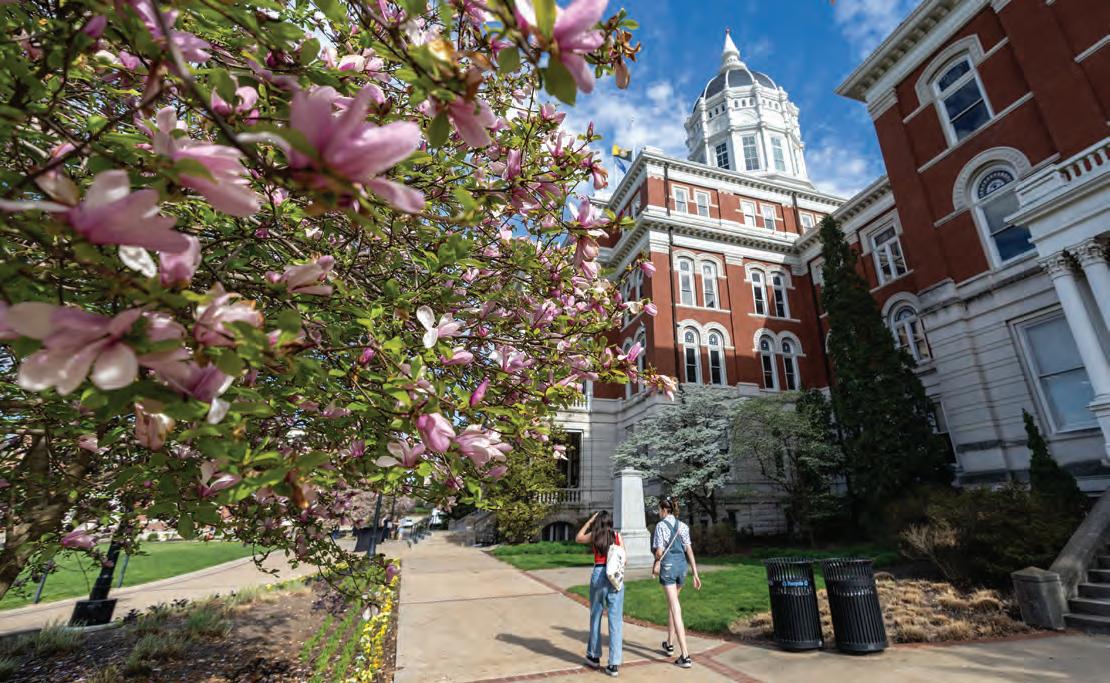
Spring Awakening
The trees on campus are hiding a secret. Actually, three secrets. With the right maps, three self-guided tree trails through the Mizzou Botanic Garden reveal themselves.
Each path winds through picture-perfect areas of the 1,252acre campus garden and offers its own floral settings and varieties of trees. The magnolia butterflies along the Memorial Union route, the golden rain tree along the Jesse Hall trail and the common eastern red cedar growing along the Lowry Mall route add color to trails that include exotic as well as Missouri native trees.
“It’s a great way for people to enjoy the garden and to get a feel for it,” says Chris Starbuck, associate professor emeritus, plant science and technology. “It’s a little intimidating at first to walk through the campus and wonder just what it is that you’re looking at.”
Tree huggers, plant geeks and anyone who enjoys the outdoors can learn more about their favorite trees or find a new favorite by taking a 30-minute stroll along the paths. “Although fall and spring are favorite times to explore the garden, there’s something beautiful to see every season,” Starbuck says.
A map is a must. Maps of each trail and descriptive factsheets are available to download at the Mizzou Botanic website, garden. missouri.edu. By following the paths, stopping to read the plaques that identify the trees and reading the accompanying
visitors learn more about the ecosystem that is the Mizzou campus and gain a deeper appreciation of the natural world.
Tree huggers, plant geeks and anyone who enjoys the outdoors can learn more about their favorite trees or find a new favorite by taking a 30-minute stroll along the paths of the Mizzou Botanic Garden.
Of the three tree trails, the Jesse Hall Loop is the longest, with 50 identified trees. Starbuck recommends the Memorial Union Loop for first-timers. It’s the shortest trail and is most accessible for people who rely on wheelchairs or have limited mobility. The Lowry Mall Loop (Ellis Library) has fewer labeled trees but does identify 29 of them embedded among an extensive assortment of colorful plants.
Looking for a deeper dive into the garden? In addition to the self-guided trails, visitors can explore on their own the 18 specialty gardens tucked into the Mizzou Botanic Garden or arrange for small-group guided walking tours led by garden volunteers, such as Starbuck, who select routes based on what’s in bloom. This year, a new guided tour is being added to the guides’ repertoire: the Discovery route, which starts across from the student center at the Thomas and Alice Payne Plaza and showcases herbs used in pharmaceuticals.
— Jack Wax, BS Ed ’73, MS ’76, MA ’87
ABBIE LANKITUS MIZZOUMAGAZINE 6
descriptive fact sheets,

Game-Changing Transformation
What fans can expect from the recently announced $250 million Memorial Stadium Improvements Project.
As with a winning Tiger football season, the numbers tell the story on the April 18 announcement that the University of Missouri Board of Curators had approved the hiring of the design firm for the approximately $250 million Memorial Stadium Improvements Project. The upgrades and reconfiguring will include up to 160,500 square feet of new construction; dozens of new suites; a potential increase in stadium capacity from 62,621 to about 65,000 (depending on finalized programming plans). Better LED lighting. Improved Wi-Fi signal.
The project, which will be designed by Kansas City architecture firm DLR Group, is scheduled to be completed by the start of the 2026 college football season. If it hits the deadline, the upgraded Memorial Stadium will open to coincide with the 100-year anniversary of Mizzou’s first game at the stadium.
10 notable upgrades that are coming:
• Enclosing the north end of the stadium.
• Adding new premium seating options along the north edge of the stadium.
TRIPLE AWARDS

• Developing 14 field-level open-air suites, 28 cabanas, two new club sections and more, for a total of up to 51 new suites.
• Building a 300-person field-level Rock M Club, which will be located under the historic Rock M Hill. The hill and the M will be preserved while providing general admission seating for up to 2,600 fans.
• Improving stadium-wide Wi-Fi.
• Introducing new premium spaces such as loge seating options and mezzanine club luxury outdoor seats.
• Upgrading restrooms and concessions throughout the stadium.
• Converting the current field-level Bunker Club in the south end zone to a team recruiting center.
• Upgrading the stadium sound system.
• Installing multi-colored LED field lighting.
Set your clock to it: In what’s becoming a regular occurrence, MIZZOU art director Blake Dinsdale, BA ’99, earned the magazine a trio of Society of Publication Designers awards. The magazine earned two design and typography awards for “VHS: Vlad Has Stories” (Winter 2023), and the Spring 2023 story “A Cosmochemist’s Guide the Galaxy” won a design award. MIZZOU magazine was honored alongside major publications including National Geographic, The New Yorker and Food & Wine.


FROM THE PRESIDENT


Igniting Minds and Lighting Up Scoreboards
I was thrilled to join thousands of Tiger fans in Texas to watch the University of Missouri defeat Ohio State University in the 88th Goodyear Cotton Bowl Classic. This historic win was further proof that our momentum is building on the field, on campus and beyond.
In this issue, you’ll learn about our many other recent achievements: We’ve already surpassed our historic high in freshmen applications for next fall and retention, and graduation rates are both at all-time highs. Our national rankings in total research continue to rise. In the prestigious Association of American Universities, we continue to increase our performance based on the important metrics of research expenditures, citations, and honors and awards. State support is anticipated to reach another historic high.
A key factor in these milestones is MizzouForward, our 10-year, $1.5 billion investment in student success, faculty excellence and infrastructure growth. To support our goals, we’re making great progress on transformative initiatives such as NextGen MURR, Mizzou’s new 20-megawatt research reactor that will produce even more lifesaving radioisotopes. In the weeks ahead, we’ll also share more about the Center for Energy Innovation, a new state-of-the art facility near the heart of campus that will secure our place as a global hub for energy research breakthroughs.
Our community is driven to find solutions, bring home championships and meet the challenges we all face. Mizzou students, faculty and staff are ready to achieve excellence and deliver results that make our state and alumni proud.
MUN Y. CHOI, PHD President, University
of Missouri
7 SPRING 2024 RENDERINGS: MIZZOU ATHLETICS
Engineering the Future
Eight student-centric tech innovations are coming to campus.
Since its inception, MizzouForward, the transformational 10-year initiative designed to strengthen innovation in research disciplines at the University of Missouri, has spurred a wave of proposals to advance student achievement. President Mun Choi and Interim Provost Matthew Martens recently revealed the 75 funded MizzouForward projects for 2024–25. Below, we highlight eight that integrate technology into the student experience.
#MizzouBuzz
@AAUniversities
Civil & Environmental Engineering

Goal: Upgrade ZOUTRANS laboratory with new technologies to support learning, recruitment and workforce development by training students to use AI to design and develop smart cities.
New gear: vehicle-to-vehicle and vehicle-toinfrastructure communication systems, drones, autonomous jetbots and more.
Geography
Goal: Update and improve the department lab with new technology, including an advanced geographic information system (GIS) and remote sensing tools.
New gear: computers, monitors, scanner plotter, ArcGIS servers and GPS receivers.
Engineering and Information Technology
Goal: Add funding to supplement the new Engineering Technology (ET) program’s hydraulics and pneumatics laboratory (Fluid Power Laboratory).
New gear: A state-of-theart hydraulics training system and a pneumatics training system capable of modern industry-standard electrical control.
Chemistry
Industrial & Systems
Engineering
Goal: Upgrade the technology platform for a majority of the undergraduate curriculum to support advanced AR training and decision making. New gear: small autonomous vehicles, a drone fleet and VR/AR equipment.
Clinical & Diagnostic Sciences
Goal: Enhance equipment to bolster student proficiency in bedside, intraoperative and trauma radiography to deepen understanding of image characteristics and streamline the evaluation of the X-ray beam.
New gear: X-ray production and measurement labs.

Marketing
Goal: Invest in AR/VR equipment for use by the Trulaske Center for Sales and Customer Development to advance knowledge and prepare future leaders in the sales area
New gear: Apple Vision Pro headsets.
Teaching for Learning Center
Goal: Invest in the NextGen Tech Exploration Sandbox, an open-access arena at the Teaching for Learning Center designed for experimentation and creative thinking. New gear: Advanced VR/ AR technologies.

Goal: Purchase equipment used extensively in the chemical industry for the organic and quantitative analysis teaching laboratories. New gear: Four gas chromatographs.
Researchers at @mizzou aim to develop radiopharmaceuticals containing terbium-161, which can deliver a lethal dose of radiation to cancer cells, causing DNA damage and preventing their multiplication.
@BenArnetKOMU
What a freakin’ scene at the #Mizzou tailgate at Globe Life Field
@BondLifeSci
Congrats to @Mizzou’s Henry Wan for receiving one of the highest professional distinctions for medical & biological engineers. The Bond LSC scientist was just inducted into the 2024 College of Fellows for the American Institute for Medical and Biological Engineering.
@MizzouResearch
@MizzouSoftball


These go to Tigers in the Polls: Week 8 #OwnIt #MIZ


@jdpickell
Mizzou continues to make boss moves in the modern era of CFB
• extend Eli Drinkwitz
• top 10 portal class
Schools that win today in CFB are the schools that make it clear they’re prioritizing CFB
@MizzouChess
Final Four Champions!!


2nd consecutive appearance at the Final Four, and the trophy is coming home to @Mizzou
8 MIZZOUMAGAZINE
ADOBE STOCK
AROUND THE COLUMNS
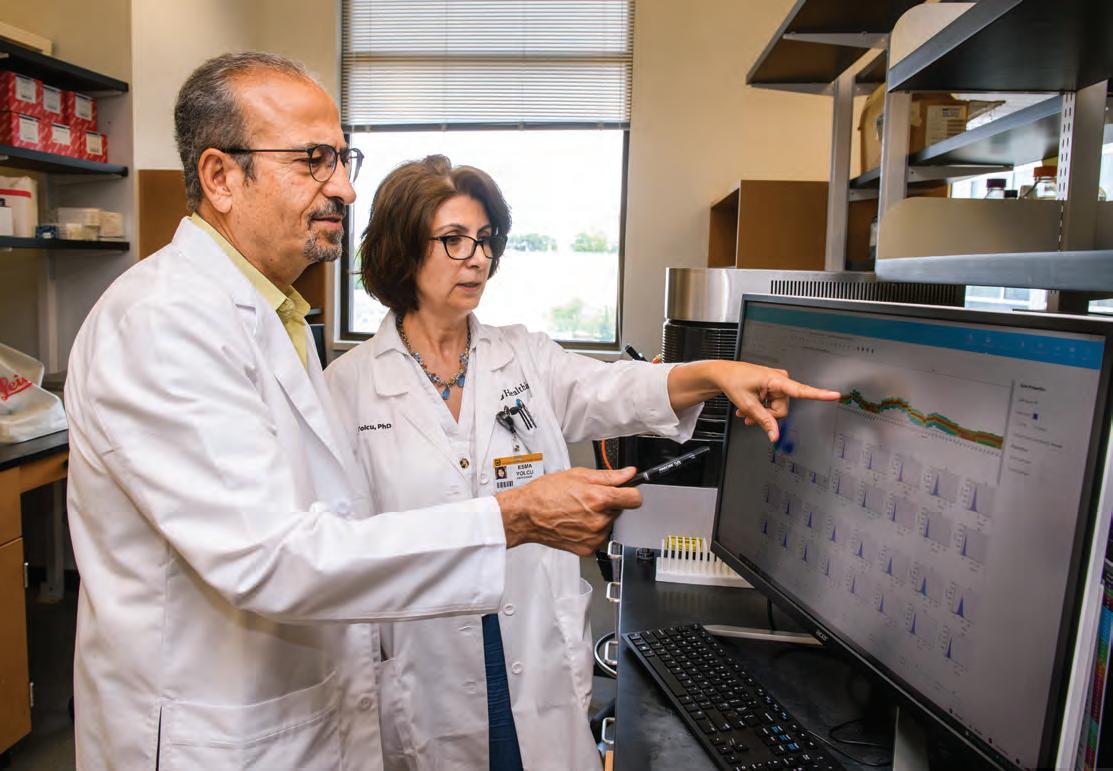
CANCER’S KRYPTONITE
Haval Shirwan and Esma Yolcu, professors at the University of Missouri School of Medicine, have achieved a feat that eludes most cancer researchers. After several decades of work, they have designed and tested a molecule that has shown the ability to prevent cancers in preclinical trials. Their solution withstood rigorous peer review before being published in a major oncology journal, Cancer Immunology, Immunotherapy.
“Our data shows overwhelming evidence that the immune system in high-risk individuals can be trained to prevent the development of nonvirally derived cancer,” Shirwan says. “This is a first in the scientific literature.”
In addition to conducting his research, Shirwan serves as associate director of the division of pediatric research and associate director of the immunomodulation and regenerative medicine program at Ellis Fischel Cancer Center. Yolcu, a professor in the Department of Molecular
Microbiology and Immunology, focuses much of her research on the treatment of autoimmune diseases, such as type 1 diabetes. They joined forces to work on cancer immunotherapy.
Their novel molecule, SA-4-1BBL, works by triggering an immune surveillance mechanism that detects and attacks invading cells or viruses. “When the immune system sees cancer as a danger signal, it tries to generate a response,” Shirwan explains. “In turn, cancer initiates a counterattack. But, if the immune system is effective enough, it gains the upper hand and eliminates the cancer it has found.”
Both researchers are eager to exploit and expand their hard-won knowledge, and they have already patented their molecule in the United States, Japan and the European Union, Shirwan says. “There must be other pathways in the immune system that we can investigate for alternate ways to prevent cancer in high-risk individuals.”
— Jack Wax, BS Ed ’73, MS ’76, MA ’87
From left, Haval Shirwan and Esma Yolcu, professors at the University of Missouri School of Medicine, compiled data that “shows overwhelming evidence that the immune system in high-risk individuals can be trained to prevent the development of nonvirally derived cancer.”
9 SPRING 2024
JUSTIN KELLEY
AROUND THE COLUMNS
IRISH TIGERS
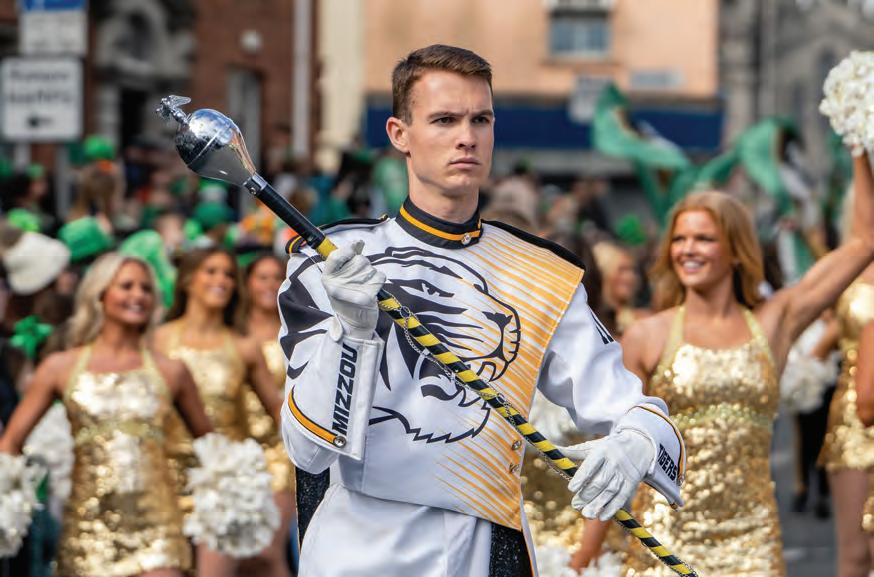
Marching Mizzou emerged victorious over 13 other bands in Dublin, Ireland, on March 17 in Dublin, Ireland, where they clinched Best Overall Band at the 2024 St. Patrick’s Festival Parade. After entertaining nearly 500,000 attendees and a global audience, the Tigers then celebrated in Tipperary, where they reinforced their melodic ties with the community. Mizzou’s fight song, “Every True Son,” honors Tipperary’s classic tune, “It’s a Long Way to Tipperary.” Students also had the chance to explore historic sites through a collaboration with Mizzou Study Abroad.
Truman Defeats Scrappy
Truman the Tiger clobbered competitors including Cocky (South Carolina), Scrappy the Eagle (North Texas) and Pistol Pete (New Mexico State) to take home gold at the National Cheerleaders Association Collegiate Mascot Championship on April 13 in Daytona, Florida. Mizzou’s Truman, the only major university mascot named after a former President of the United States, succeeds the 2023 winner, Buzz of Georgia Tech.
A dynasty in the making? The same day Truman clobbered Cocky and Scrappy in Daytona, the Mizzou cheerleading squad won its second straight National Cheerleaders Association (NCA) Championship. Coach Cynthia Metz and her Tiger squad earned the win in the Intermediate Large Coed Division IA competition, besting East Carolina, Georgia Southern and Kansas State.

2024 Kemper Winners Revealed
Established in 1991 with a $500,000 donation, the William T. Kemper Fellowship for Teaching Excellence honors the legacy of Kemper, a distinguished civic leader and 1926 University of Missouri graduate. Throughout his illustrious 52-year banking career, Kemper held top positions in Missouri, Kansas and Oklahoma until his passing in 1989. The fellowship, administered by Commerce Bank, grants a $15,000 stipend to five exemplary educators annually at the University of Missouri. This year’s recipients are:
Nicole Campione-Barr, Psychological Science
Jason Furrer, Molecular Microbiology and Immunology
Seth Howes, Languages, Literatures, and Cultures
Amy Knopp, School of Music

Chris Prestigiacomo, Accountancy
10 MIZZOUMAGAZINE
PARADE: SAM MOHLER; CHEER: MIZZOU ATHLETICS; APPLE: ADOBE STOCK

CSR Chic
Quality and price aren’t the only things that matter to consumers today. Buyers also consider a company’s corporate social responsibility (CSR) efforts when shopping. For example, does a company practice sustainability by reducing its impact on the environment? Does it protect workers manufacturing its products? And how does it make consumers aware of its societal impact?
According to University of Missouri Professor Jung Ha-Brookshire, if companies want to shift toward sustainability, employees need to be aware of employers’ social initiatives and act as ambassadors to inform consumers of these CSR activities.
Ha-Brookshire, professor in the Department of Textile & Apparel Management in the College of Arts and Science, and her colleagues recently conducted a survey of employees and consumers of Nike and H&M. Both clothing brands were named among the most sustainable companies in the world by the nonprofit Corporate Knights. The research team asked consumers about the companies’ sustainability practices, and they queried employees on what CSR’s role should be in the fashion industry and how well they feel their company performed.
“We hypothesized that the bigger the CSR performance-perception gap is, the less committed to their companies an employee will be,” Ha-Brookshire says. “With less commitment, are employees going above and beyond for their company — what we call organizational citizenship behavior?”
The study, published in the journal Fashion and Textiles, found that although both Nike and H&M employees felt their respective company was doing a good job with sustainability, consumers’ perceptions toward these companies’ CSR performance were not as positive as employees’ perceptions were. Additionally, the research team’s hypothesis proved correct. A larger performance-perception gap led to less job commitment by employees, which resulted in declining organizational citizenship behavior, such as being less inclined to involve themselves in community sustainability programs.
Ha-Brookshire and team say the survey findings show companies have an opportunity to improve the communication of their sustainability and CSR practices and ultimately expand their consumer base.
While companies certainly play an important role in sustainability, Ha-Brookshire stresses that consumers also have responsibilities. “What consumers do after purchasing and using products — how they discard products at the end — is just as important as a company’s CSR activities,” she says. “We’ve got to work on sustainability together.” — Blaire Leible Garwitz, MA ’06
• The State Historical Society of Missouri and the Department of Textile and Apparel Management have teamed to present “Ginger Rogers: Dressed to Impress.” The exhibit displays the famed actor and style icon’s elegant dresses, which are housed in the department’s collection. The collection will be presented through Aug. 31.
• The University of Missouri has received $5.5 million from the National Science Foundation to serve as a hub for transforming research into real-world applications. As one of 18 academic institutions to receive an Accelerating Research Translation award, the university will use the funds to establish a Technology, Entrepreneurship and Commercialization Hub.
• Recent research published in the journal Psychopharmacology suggests that the decades-old drug propranolol can alleviate anxiety in children and young adults with autism. Led by David Beversdorf, a clinician at the University of Missouri’s Thompson Center for Autism and Neurodevelopment, the study found that individuals on the spectrum who took propranolol exhibited significantly less anxiety after three months compared with those given a placebo.
• MU researcher Kelli Canada has received a $2.8 million grant to collaborate with five Missouri prisons over the next five years to advance a plan to improve skills for people leaving prison.
11 SPRING 2024 BLAKE DINSDALE
Briefly
Jung Ha-Brookshire weaves social responsibility into fashion’s fabric.

LAIRD VEATCH TAKES CHARGE
Hours before this issue of MIZZOU went to press, University of Missouri officials named Laird Veatch as the new director of athletics. Veatch, who has served in the same position at the University of Memphis since October 2019, is a former football student-athlete at Kansas State University and boasts 25-years of athletics experience in the Big 12 and SEC.
“Mizzou has always had a passionate and dedicated fanbase, including broad support throughout the state, and together there is nothing that we cannot accomplish,” Veatch said. The new AD’s stated goal? “[W]inning SEC and NCAA championships while providing our student-athletes with a tremendous experience.”
Veatch worked in the Mizzou athletic department from 1997-2002. Among other
successes, he oversaw the department’s fundraising activities and managed the Tiger Scholarship Fund. At Memphis, Veatch orchestrated a $200 million football stadium renovation and recently secured an innovative $25 million name, image and likeness (NIL) agreement with FedEx that will benefit Memphis studentathletes who promote company initiatives.
“We are thrilled to welcome Laird back to Mizzou as our new athletic director,” Board Chair Robin Wenneker said.
His appointment comes at a pivotal time. In mid-April, the Board of Curators unanimously approved plans to invest $250 million to transform and modernize Memorial Stadium. The commitment followed the 2023 football Tigers’ Cotton Bowl victory and 11-2 record.
Libero Activist
When Dawn Sullivan left UNLV to become Missouri’s volleyball coach in 2023, she faced the daunting task of rebuilding a program that had finished last in the Southeastern Conference the previous two years. Fortunately for Sullivan, she wasn’t coming from Las Vegas alone.
Maya Sands decided to follow her coach to Mizzou. Sands, a junior, is an elite libero — a back-row defensive player — and she immediately elevated the Tigers’ talent level. Just as important, she knew exactly what Sullivan expected from her players and helped accelerate the team’s acceptance of a new culture.
“When I committed, Dawn and I talked a lot about where we wanted to take this program and how we wanted to see it grow,” Sands says. “My main focus was what I could do to make sure we, as a team, could be successful. I didn’t want to come in sounding really bossy, but I slowly started to implement the routines we did at UNLV. It was simple things like going out five minutes early before practice and getting extra reps.”
Teammates followed her lead.
Sullivan calls Sands “one of the most disciplined individuals you will meet. She sets the expectation and drives the behaviors and future habits. She essentially says, ‘Climb on, let’s go. This is what we’re going to be about.’”

The coach adds that many players find it tough to know when to push and when to let a team find its own direction. “But Maya does that so well,” Sullivan says. “She has such an internal drive but also a kind ness and openness to let people grow in their personal space.”
The Tigers went 18-13 overall, including 9-9 in the SEC, and earned an NCAA Tournament berth. Sullivan was named the SEC coach of the year. Sands, who led the conference with 4.71 digs per set, was tabbed the SEC libero of the year.
The success and recognition validated how far Sands has come in a short period. She didn’t even start playing the libero position until her senior year of high school in Rock Falls, Illi nois. She received no scholarship offers from power conference schools, but Sullivan liked her scrappy style and offered her a chance to play at UNLV.
Since relocating to Missouri, they’ve proven together that they belong at the highest level of college volleyball.
— Joe Walljasper, BJ ’92
This season, volleyball player Maya Sands led the conference with 4.71 digs per set and was named the SEC libero of the year. The Tigers went 18-13 overall and 9-9 in the SEC.

12 MIZZOUMAGAZINE
THE COLUMNS SANDS: MIZZOU ATHLETICS; VEATCH: MEMPHIS ATHLETICS PHOTO, BLAKE DINSDALE PHOTO ILLUSTRATION
AROUND


TIM JAMIESON’S TIGER CURVEBALL
In May 2023, Tim Jamieson received word that he was elected to the University of Missouri Intercollegiate Athletics Hall of Fame. It was a great honor for Jamieson, whose successful 22-year run as head baseball coach ended in 2016. It provided closure on the black-and-gold era of his career.
Or so he thought.
A month later, Missouri hired Kerrick Jackson as its new head baseball coach. Jackson previously had been an assistant under Jamieson at MU, and more recently Jamieson had served as Jackson’s pitching coach at the University of Memphis. Jackson asked Jamieson if he would join him in the same role at Missouri.
“We had just sold our house in Columbia in January 2023,” Jamieson says. “We had moved on. I never envisioned being back in Columbia, let alone coaching baseball at the university. I wasn’t 100% sure I wanted to do it, but as the former players started to reach out, they were excited about it. They’ve always been an inspiration for me.”
Suddenly, his Mizzou athletic career was no longer in the past tense.
At this stage of his career, Jamieson enjoys getting the chance to teach without the stress and administrative duties of being a head coach. One of his strengths is finding and developing future MLB pitchers — most notably Max Scherzer — and now he gets to focus specifically on that task. And who better for Jackson to lean on for advice than a hall-of-fame coach?
“At whatever point in time I’m finally done — and I hope it’s not any time soon — I want to
have the program be in a better place than it was when I left the first time and where it was when we came back,” Jamieson says. “That’s a pretty strong motivation.”
— J.W.
Batoon Time
The University of Missouri football team’s defense, last seen dominating Ohio State in the Cotton Bowl, is under new management in 2024. Corey Batoon took over as the Tigers’ new defensive coordinator in January.
Batoon has coached for more than three decades, including a stint in the SEC at Mississippi from 2012–2016. Most recently, he was the defensive coordinator at South Alabama. Under his guidance, the Jaguars ranked 15th nationally in total defense in 2023. They gave up just 313.2 yards per game.
“He’s a veteran coach who’s battle-tested and has an ability to break things down and teach the game at a high level,” Mizzou Coach Eli Drinkwitz said in a press release. “I’m excited to see him bring those skills and experience to fit with our defensive approach.”
— J.W.
Scoreboard
2 — Super Bowls won by Andy Russell, a former Tiger who starred at linebacker for the Pittsburgh Steelers in the 1960s and 1970s. Russell, who made the Pro Bowl seven times, died on Feb. 29 at age 82.
3 — All-American finishes by Mizzou wrestlers at the NCAA Championships. Keegan O’Toole placed third at 165 pounds, Rocky Elam took sixth at 197 pounds and Zach Elam finished fourth at 285 pounds.
4 — Number of Missouri women’s basketball players who have scored 2,000 career points. Hayley Frank reached the milestone in the regularseason finale on March 3 and joined an exclusive club that also includes Sophie Cunningham, Joni Davis and Renee Kelly.
9 — Years between PGA Tour victories by former MU golfer Peter Malnati, who won the Valspar Championship on March 24 for his second career win. Malnati shot a 12-under-par 272 to win the event by two strokes in Palm Harbor, Florida.
10 — Scores posted by Mizzou gymnasts Mara Titarsolej, Sienna Schreiber and Jocelyn Moore during the 2023–24 season. Titarsolej earned a perfect mark on the parallel bars on Feb. 16, Schreiber accomplished the feat on the balance beam on March 3 and Moore completed a flawless floor exercise on March 17.
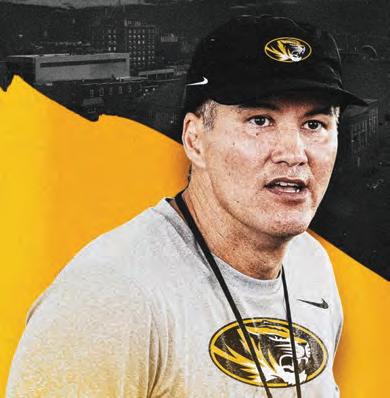
13 SPRING 2024 MIZZOU ATHLETICS
YOUR NEXT ADVENTURE AWAITS!
Why book with us?
- Skip the planning. No matter the destination, our experts and tour guides ensure all the finer details are accounted for.
- Worry-free travel. Even when the unexpected happens, our operators will ensure your trip still meets expectations.
- Incredible value. Every tour is jam-packed with exciting locales and unmissable stops; you’ll make the most of every minute.
- Broader horizons. From culinary adventures to educational tours, let us show you the hidden gems that others miss.
- Tiger spirit. Nothing makes travel better than a good friend — and our trips come with camaraderie built right in.
The world is waiting.
Book your next adventure today: Mizzou.com/Travel







14 MIZZOUMAGAZINE
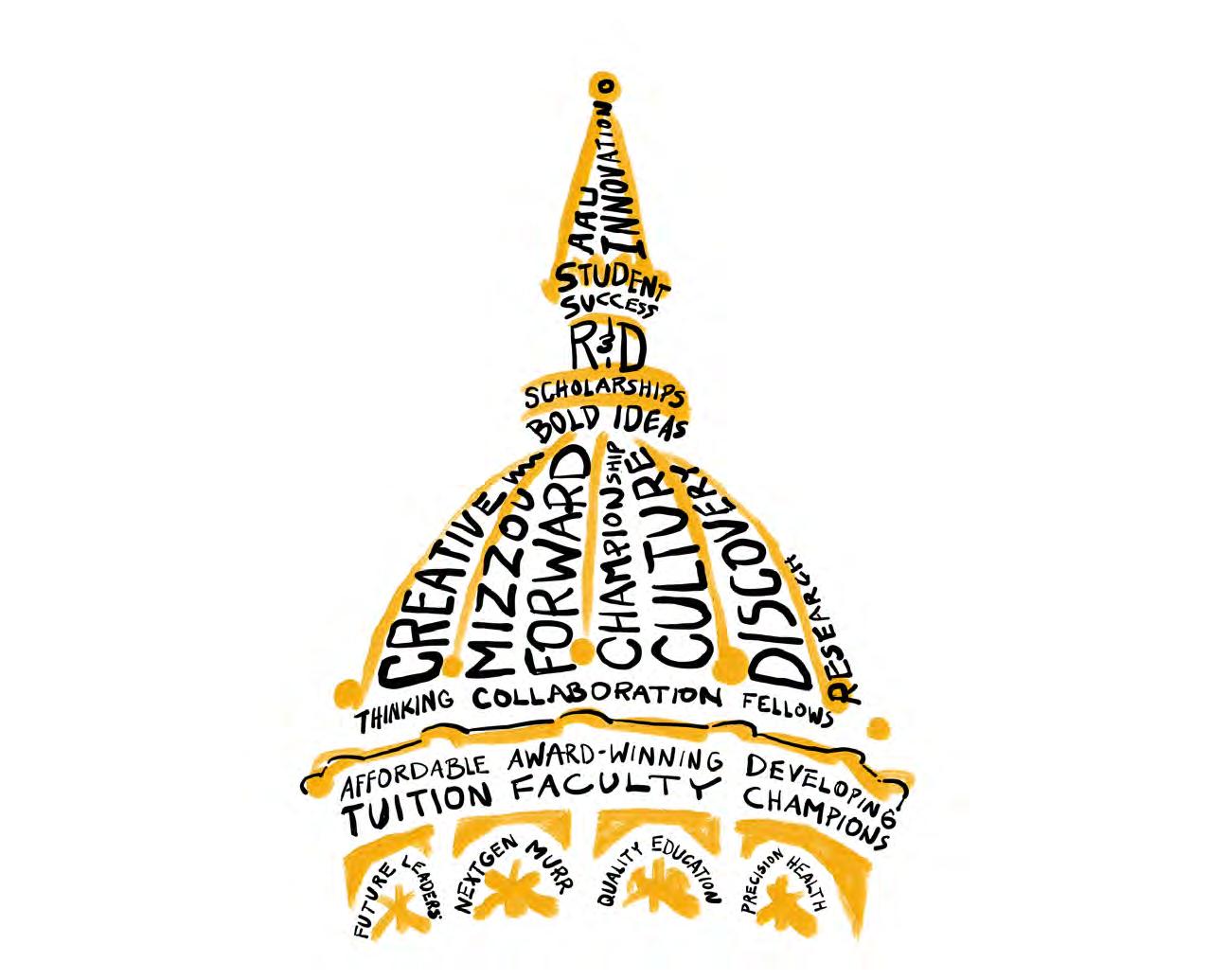
15 SPRING 2024 Help ensure Mizzou remains nimble enough to compete and thrive as a leading research institution. Please support the Chancellor’s Fund for Excellence today. mizzou.us/cfe • 573-882-6511 SCAN ME WHAT DOES IT TAKE TO ACHIEVE EXCELLENCE?
Gateway the Greening
Meet four parks directors who are cultivating an outdoor St. Louis renaissance. (Spoiler alert: They’re all alumni.)

 Story by Amanda Doyle, BJ ’94
Story by Amanda Doyle, BJ ’94


| SPRING 2024 17
MIZZOU



AAs warmer weather sets in and daylight extends beyond dinner, many of us are carving out space for evening walks in the park or weekend picnics along favorite trails. For the millions of visitors each year to St. Louis’ most popular and celebrated green spaces, those excursions fall under the direction of a University of Missouri graduate.
To be precise, four Mizzou alumni are the lead executives of some of the region’s largest parks and greenways. The Tiger quartet finds common cause, and sympathetic ears, in their work to elevate the city’s natural lands.
“We’re our own support group,” says Bill Reininger, BS ’92, director of Tower Grove Park, a 151-year-old Victorian park and National Historic Landmark in the heart of historic south St. Louis.
As with Reininger and Tower Grove Park, each has a distinct domain. Susan Trautman, BS ’80 MPA ’87, is the CEO of Great Rivers Greenway, a region-spanning network of parks and greenways. Ryan McClure, BJ ’03, is the executive director of the Gateway Arch Park Foundation, a nonprofit conservancy supporting the Gateway Arch National Park. Lesley Hoffarth, BS CiE ’88, is the president and executive director of Forest Park Forever, a private nonprofit created to restore, maintain and sustain the massive urban park in the city’s central corridor.
Combined, the four guide the support, planning and appreciation for outdoor communal gathering spots, essential components of livable cities. “The pandemic taught us that green spaces are a necessity, not an amenity,” Reininger says.
Despite their parks’ varying governance structures, funding sources, partnerships and individual personalities, these leaders are a known entity as a group, both within St. Louis and nationally. Their commonalities and a shared approach override any disagreements. McClure describes a working relationship enabled by “a genuine friendship and admiration between all of us that does not exist in a lot of communities among park leaders,” adding that “in other areas with lots of different organizations like ours, there are just competing agendas.”
Such extreme collaboration isn’t necessarily a given. It’s the secret sauce in St. Louis, though, and it has earned the city recognition far and wide, including praise from national organizations the Trust for Public Land and City Parks Alliance.
The formula is simple: “We trust each other. We all know that when we work together, the city rises together,” Trautman says.
Public, private and philanthropic money make these organizations possible, but in different combinations. Tower Grove Park, for example, is overseen by a board of commissioners that is mostly separate from the city park system. Forest Park Forever has an operating agreement with the city and its parks department but does its own fundraising to support restoration projects and an endowment. Great Rivers Greenway exists as a public agency created by a voter-approved, dedicated sales tax for parks and greenways. And Gateway Arch Park Foundation emerged in 2009 as the first philanthropic partner of Gateway Arch National Park.
“In common, we share a commitment to providing incredible green spaces to people in the St. Louis region,” Trautman says — before Hoffarth finishes the sentence: “And an interest in being as welcoming and inclusive as we can to reach out to folks who wouldn’t naturally find themselves in our spaces,

without some support and encouragement.”
Modern day park administration remains the kind of scrappy, resourceful field it always has been, Trautman says. “It’s legacy work. It’s a pay-it-forward kind of career.” Planning for the decades and centuries ahead embodies the proverbial wisdom of planting trees whose shade you’ll never see.
The job today, though, has become tougher and more politicized. Parks, like many public spaces, face social issues that demand direct conversation and solutions, from unhoused citizens to histories of racial inequity. The funding provided by municipal and state governmental bodies is often not enough to maintain levels of repair, cleanliness, safety and amenities modern users expect.
Each director has a story, an “aha!” moment that makes long hours of community meetings, congressional lobbying and consensus-building crystallize into meaning.
Hoffarth recalls attending the annual hotair Balloon Glow with her then-8-year-old son. It was the first year she worked at Forest Park after a career with the Missouri Department of Transportation, she says. “We walked from the visitor center, and we get to Central Field and he starts running and he goes, ‘Wow, this is so great! You used to have a highway and now you have a park!’” McClure admits to tearing up when he sees a father and son playing catch on the Arch grounds.
Reininger still gets a thrill from the work — and from how appreciative people are when they learn what he does for a living, he says. “At dinner parties or gatherings anywhere, when people ask what I do, and I say, ‘I work for Tower Grove Park,’ the reaction is immediately, ‘Oh, my gosh! I love that place.’ They want to tell you all the ways they are connected to it.” He says he reminds everyone on the team, from the maintenance crew to office managers, that their work contributes to building community and family memories.
Meaningful moments in the field can take their creators by surprise. Trautman recalls the ribbon-cutting for a pocket park in Wellston, a tiny city in St. Louis County where years of disinvestment have taken a steep toll. “A little one-acre park is my favorite park I’ve ever built. Near the construction fencing, an elderly man was crying outside the fence, and I thought, ‘What’s wrong? ‘I never thought I’d see this day,’ he said. That has stayed with me forever.”
18 MIZZOUMAGAZINE
LOUIS PARK LEADERS
ST.

left:
Although each arrived at their position from a different pathway, they all graduated from Mizzou. Combined, the quartet oversees some of St. Louis’ most prominent parks and trails.


Left: A map identifies three major St. Louis parks that, combined, feature destinations including the Gateway Arch, the Old St. Louis Courthouse, the St. Louis Zoo, the St. Louis Art Museum, the St. Louis Science Center and more. The three parks comprise a total of 1,751 acres. Above: The 135-mile network of trails that make up the Great Rivers Greenway includes routes that surround and connect the St. Louis metropolitan area. When completed, the recently announced Brickline Parkway in St. Louis City will connect Forest Park to the Arch and Tower Grove Park to Fairground Park.
19 SPRING 2024 ABBIE LANKITUS
55 64 44 Forest Park Tower Grove Park Gateway Arch Park 100 366 30
St.
From
Bill Reininger, Lesley Hoffarth, Susan Trautman and Ryan McClure.
Kirkwood Chesterfield O’Fallon
Charles Eureka
The Mizzou Parks & Rec Cartel
Clayton St. Louis Riverview

Engineered for Success
Lesley Hoffarth, Forest Park Forever


the signature of the park’s biggest fundraiser, the Hat Luncheon.
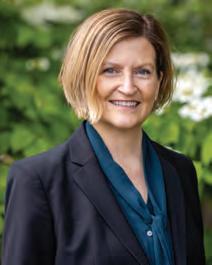
Frilly hats are a visible reminder of the twist her career took in 2010, when she left two decades at the Missouri Department of Transportation to work for the park. Hoffarth attended Mizzou as a first-generation college student from what she calls “a blue-collar, Brady Bunch blended family” in southwest Missouri, but she wasn’t sure where she would land.
She started as a computer science major but switched to music, and then housing and interior design. “When I was designing these multistory homes for class, professors said, ‘Design what you want and give it to a civil engineer to see if it’ll work.’ And I thought, ‘Forget asking and waiting. I can do that!’”
When Hoffarth interviewed on with MODOT on campus during her senior year, it immediately clicked. She took assignments focusing on bridge design, maintenance, and traffic and construction. She engineered bridges around the state, which in 1988 meant designing on a FORTRAN computer “and then walking down the hill by the Capitol to the MODOT garage to pick up your printout from the single printer we had.” Four years later she moved to St. Louis and into roadway design and project management.
The culminating project of her MODOT career was the 10year rebuilding of I-64 through St. Louis. The project required all the hard and soft skills she’d spent years honing.
“I had a lot of coffee in kitchens and ate a lot of chocolate chip cookies walking around backyards during our five years of planning for the highway rebuild,” she says, noting the “multiple municipalities, numerous public officials, and countless neighbors we had to bring on board.”
Her work on the highway project drew the attention of Forest Park Forever, which was looking for a leader to revitalize the park after a period of stagnation. The job involved taking on maintenance, committing to an ambitious restoration and assuring the landmark park’s legacy and future. Never having worked in the nonprofit sector, Hoffarth counted on her collaborative skills and took a leap of faith. It’s been a successful formula.
“Our donors and our constituents work with and trust us because we say what we’re going to do, and we do what we say,” she says. “People continue to invest in things they feel are well managed, with good practices and an exceptional product. And we deliver exceptional places.”
Forest Park Forever’s mission is to maintain and improve upon the plot of land at the center of St. Louis. Highlights at the park include its many cycling and walking trails, celebrations at its numerous indoor and outdoor pavilions, grand gardens and crucial artistic and historic documents.



20 MIZZOUMAGAZINE
PHOTOS COURTESY OF FOREST PARK FOREVER
FOREST PARK





Destined for Recreation
Susan Trautman, Great Rivers Greenway

Susan Trautman was the first in her family to attend college, and she made it look easy. She arrived on campus armed with a slew of AP credits from high school and “parks and recreation” as the answer to “What do you want to do?”


“That was based almost entirely on my experience of being a camp counselor for the city of Bridgeton when I was 14,” she says, laughing. Still, something about her direction must’ve been right, because she earned a bachelor’s degree in three years and thrived with the support she found at the university.
“The culture of parks and recreation is a pay-it-forward, mentoring sort of environment, and that’s the way it was in the school,” she says. She remembers the family feeling, with just 70 students in her cohort and extraordinary mentoring from people such as the late Charles “Randy” Vessel (MPA ’75).
From an internship in Scotland to work with the Missouri State Parks, Trautman gained a wide network of contacts that proved helpful as she moved through future jobs. She served in park system administration and city master planning. She opened the Center of Clayton, served the city of Des Peres as director of Parks and Recreation. She had an epiphany along the way: “I am at heart a public servant. That same parks and rec culture I encountered in school “of sharing information, resources and support is still relevant to the work I want to do to benefit the community.”
Coming into leadership of Great Rivers Greenway in 2010, with a regional focus and a huge number of collaborators, presented a new kind of challenge. She’s handled it with the kind of understated aplomb displayed in her previous assignments and ended a record-breaking 2023 with a ribbon-cutting on eight new greenway projects.
“The culture of parks and recreation is a pay-it-forward, mentoring sort of environment, and that’s the way it was in the school,”
Next up, the Brickline Greenway. Featured in a summer 2023 New York Times wrap-up of notable urban walks, this project tackles an ambitious set of priorities. Trautman describes it as “a transformational infrastructure project that incorporates racial equity and economic development” to help rebuild the city and keep it nationally competitive as a place that attracts and retains talent. She adds, “When it’s complete, we’ll be connected from Forest Park to the Arch, and from Tower Grove Park to Fairground Park.”
Circling the St. Louis metropolitan area in a nearly continuous loop, the Great Rivers Greenway has evolved into a varied and versatile series of destination for hikers, cyclists and picnickers.
21 SPRING 2024
GREAT
PHOTOS COURTESY OF GREAT RIVERS GREENWAY
RIVERS GREENWAY

The Tree Guy
Bill Reininger, Tower Grove Park



can actually get paid to do that.’ I took a personality and career test in grade school, and it said ‘forestry.’ So I pretty much knew.” He knew that meant choosing Mizzou, as it was the only Missouri university with an accredited forestry program.
He finished his degree in four years, then took an additional year to add a second bachelor’s degree in horticulture.
But a funny thing happened on the way to the forest. An internship with the forestry division of the city of St. Louis after his freshman year exposed Reininger to urban forestry, which had twin appeals. First, he gained a new appreciation for the meaning of trees in the city. “In an urban situation, every tree matters,” he says. “It’s somebody’s tree in their front yard. Or in a park, it’s potentially a tribute to somebody. It’s much different than doing forest management, where it’s just literally thousands of trees.”
Second, he realized that the culture available in a city was exactly his speed. Once he connected his desire to “play with trees” with the concerts and movies and restaurants he wanted to access, his shift to urban forestry was complete.
A highlight of his time at Mizzou was the Forestry Club, which he credits with “helping shrink the school down from tens of thousands of people to a much smaller group.” Every fall brought Conclave, a skills competition among students from other forestry schools such as Purdue and SIUCarbondale. Traditional activities including axe throwing, buck saw and log rolling filled weekends.
“Ever since I was a kid, I wanted to live out in the woods. And my dad said, ‘If you get a degree in forestry, you can actually get paid to do that.’ ”
Reininger’s career path spanned multiple forestry and horticulture positions, from the Missouri Botanical Garden to University City forestry to the city of Crestwood as a park operations supervisor, and then to Forest Park Forever for a decade. At Tower Grove Park, Reininger oversees a historic Victorian landmark that’s also a level II accredited arboretum and an active center of neighborhood life and recreation.
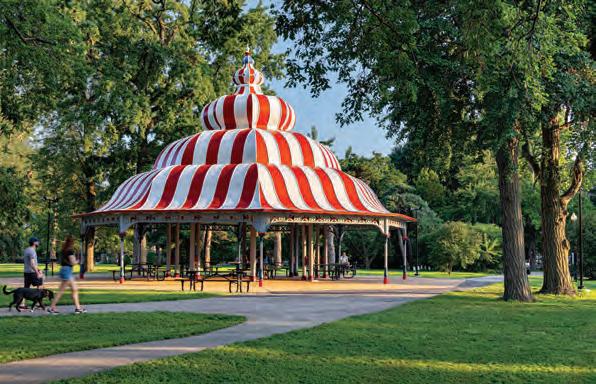

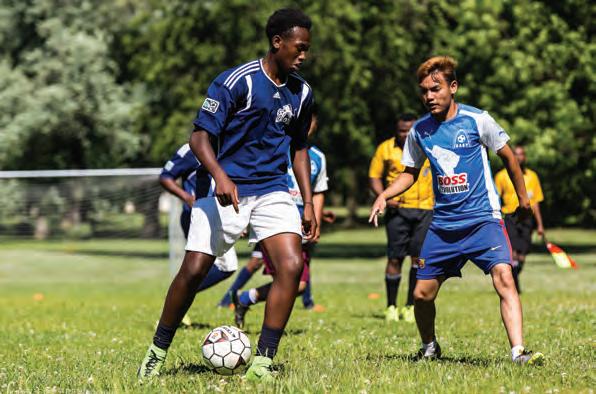

22 MIZZOUMAGAZINE
PHOTOS COURTESY OF TOWER GROVE PARK
TOWER GROVE PARK
As shown in the photos on the right, Tower Grove Park in South St. Louis is a magnet for those who love picnics, parades, soccer games and wedding ceremonies.





Ryan McClure, Gateway Arch Park Foundation From J-School to Park Nerd
Ryan McClure seemed destined for Mizzou. A second-generation Tiger who grew up in Jefferson City, he was a cheering fan during the hey day of basketball players such as Jevon Crudup and Anthony Peeler.

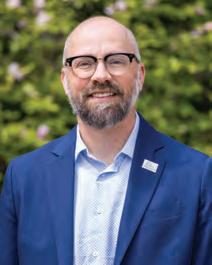
“I had that love for Mizzou from early on,” he says. By the time he made it to Kirkwood High School, he knew journalism was what he wanted to do, so he planned to attend the journalism school and become a broadcast producer.
“I went through three different sequences, from broadcast to news ed to advertising,” he says. “Then somewhere along the line I had a conversation with my mom, who had done public affairs for state government, about her experiences and projects she knew had really impacted the people of Missouri.” That guidance set him on a public relations path.
A public affairs internship at the Missouri Department of Transportation was followed by five years at PR firm FleishmanHillard in St. Louis. “That’s where I learned a whole lot and really caught fire for making St. Louis the best that it could be,” McClure says. It’s also where he met his wife, Beth (BJ ’04). When CityArchRiver, the precursor agency to Gateway Arch Park Foundation, got its start, he knew he wanted in.
“That was a dream job for me, this ambitious project to completely reshape the way that people experience Gateway Arch National Park — this symbol that undeniably represents our entire city to the world,” he says. “I couldn’t think of anything I wanted to be part of more.”
Now he geeks out on the many details of park management, from advocating for increased funding on Capitol Hill to filling his camera roll with photos of trash cans from parks he visits in other cities.
There’s no doubt in McClure’s mind that Mizzou led to his realized dream.
“Going to the J-School and having the experiences I had there means a lot,” he says.“I think particularly about classes with a public relations focus, with Margaret Duffy, that were just fantastic. These professors had the real-world chops to prepare me for where I wanted to go.” M
“That was a dream job for me, this ambitious project to completely reshape the way that people experience Gateway Arch National Park — this symbol that undeniably represents our entire city to the world.”
Although the Gateway Arch is the towering centerpiece, the national park that contains it also supports leisurely walks overlooking the Mississippi, yoga sessions and winter ice skating.
23 SPRING 2024
GATEWAY
PHOTOS COURTESY OF GATEWAY ARCH NATIONAL PARK
ARCH PARK


Using satellite imagery, MU anthropologist Rob Walker explores the timeless lives of the Amazon’s isolated tribes.
24
STORY BY DALE SMITH, BJ ’88
MIZZOU | SPRING 2024
THE SILENT GUARDIANS

OF LOST WORLDS

GGoogle Earth and other highflying technologies allow us to view the deepest reaches of the Amazon River Basin, an area that remains home to indigenous people who live as their ancestors have for thousands of years.
Scholars of rainforest ways, they hunt, gather and grow their own food in the severe terrain at the Amazon headwaters with no regard for the satellite eye above. They heal themselves with medicines culled from their surroundings; shelter and clothe themselves with local material; and protect themselves with weapons of their own devising.
Mizzou researcher Rob Walker calls them “the most traditional humans on the planet, living remnants of human life before the dawn of agriculture, the first guardians of the forest. Yet what we see now is just a tiny sliver remaining who are still uncontacted.”
Before Europeans arrived in 1500, Amazonia had thousands of tribes with populations in the low millions, says Walker, associate professor of anthropology. But since that initial contact, epidemics — first smallpox and measles, lately

COVID — have decimated indigenous populations. Early exploitation, including slavery, largely has given way to the occasional fatal conflict with illegal gold miners and loggers, as well as drug runners and others who impose themselves on tribal lands.
Walker’s new research looks at satellite images spanning more than two decades to track whether populations are growing under controversial government no-contact policies. “This approach says the tribes have survived for thousands of years, so, ‘Let them do them, and they’ll be fine.’ But that’s difficult to say, as they are in close proximity to people who don’t wish them well.”
Of the roughly 30 uncontacted tribes in the Amazon Basin, Walker’s study follows the two largest, named here for their language family: Pano and Yanomami. Satellite photos reveal not only large-scale deforestation from logging and mining but also village-scale alterations in the landscape. Walker analyzed the number of village buildings and the area of each hut’s roof. Judging by their similarity and other clues, he suspects the tribes have egalitarian social structures.
Both groups supplement their hunting and gathering with slash-and-burn agriculture, in which they cut down vegetation and set it ablaze to clear land for crops. Walker uses software that measures the fields and detects smoke from the fires. Growing primarily sweet manioc, a root vegetable, or plantains for three to five years exhausts the soil, and then the tribes start anew at another site. Within about seven years, the forest reclaims the previously used land.


Most successful are the uncontacted Pano, whose population Walker estimates at 500 to 1,000. Since 2001, land they’ve cleared for gardens has expanded rapidly, averaging greater than 10 percent annual increases as the tribe has grown from two clusters of villages to four.
He is encouraged by such “fissioning” of groups. “Populations are more resilient if they split into subpopulations with gene flow across them as people seek mates in different villages.” There’s also strength in numbers. The Pano now have so many warriors that neighbors offer gifts of machetes, axes and even gardens to remain in their good graces.
The uncontacted Yanomami, at a population of about 100, also appear to be trending up, as their village recently doubled to two clusters.
Top inset: Approximate locations for uncontacted Yanomami in their circular village (shabono), 55 meters in diameter, on May 5, 2016. Bottom inset: example cluster of longhouses (white arrows), each about 20 meters long, of uncontacted Pano speakers in Acre, Brazil, on August 6, 2015.
26 MIZZOUMAGAZINE RESEARCH
Yanomami
PREVIOUS PAGES: BRUNO KELLY/AMAZÔN REAL; THIS PAGE: MAP: ADOBE STOCK; INSETS: MAXAR TECHNOLOGIES, INC Peru Brazil Colombia Ecuador Atlantic Ocean Pacific Ocean Venezuela
Pano

With intact forest and clean water, they sustain themselves in a harsh environment.
They help us recognize the importance of respecting people and their wishes to pursue a way of life as they know it.”
But Walker is worried about the other 28 tribes. “They are small, nomadic and hard to track. They don’t make the clearings our satellite images can spot. Most of what we know about them is through accidental contacts.” One such group in Peru appears robust, judging by its bold raids on other tribes. However, Walker suspects most tribes live near the edge of extinction. “I would hesitate to say we should leave them uncontacted. Without medical care, protection and other assistance, in 20 years they may have blinked out.”
Walker’s sky-level research dovetails with onthe-ground reporting such as that detailed by Scott Wallace, MA ’83, in his bestselling book, The Unconquered: In Search of the Amazon’s Last Uncontacted Tribes (Crown Publishing, 2011).
“Satellite images are instrumental in leading concerned people, including real efforts by governments, to confirm the presence of isolated groups,” says Wallace, associate professor of journalism at the University of Connecticut. With that information, governments can make policies to protect land from the likes of illegal miners and
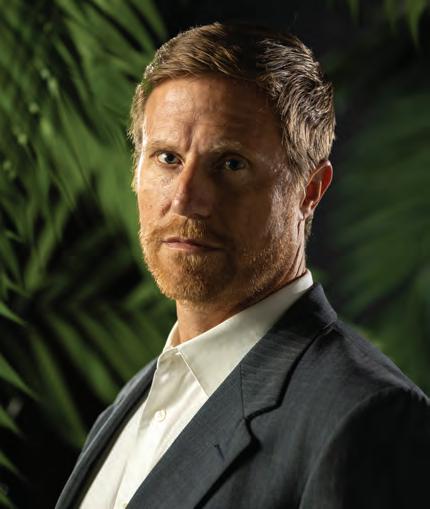


track threats such as logging and ranching that intrude into tribal territories.
Most people consider uncontacted tribes — if they consider them at all — to be exotic curiosities, Wallace says. “Perhaps their biggest value to the wider world is to fire imaginations about what 99 percent of human history was like before agriculture and the industrial revolution. With intact forest and clean water, they sustain themselves in a harsh environment. They help us recognize the importance of respecting people and their wishes to pursue a way of life as they know it.”
More: Read Walker’s article at mizzou.us/naturewalker M
left: Large mining area with dozens of barracks in the Uraricoera River region in the Yanomami Indigenous Land. Top right: MU researcher Rob Walker. Bottom and inset: Taking photographs from lowflying aircraft is a doubleedged proposition, Walker says. Although tribe members can find flyovers intrusive, publishing human-scale images may evoke empathy and support in ways satellite photos cannot.
27 SPRING 2024
Top
DRONE: BRUNO KELLY/AMAZÔN REAL; VILLAGE AND TRIBE: GLEISON MIRANDA/FUNAI; WALKER: ABBIE LANKITUS

WINNING STREAK MIZZOU’S
Celebrating increases in research grants, enrollment, student success and more.
AS THE STATE’S FLAGSHIP institution of higher education, the University of Missouri has built its reputation by showing the positive effect it has on Missouri and Missourians annually. In the high-priority areas of research, enrollment, student success and status, Mizzou has continued a steady climb in 2024 among peers in the Association of American Universities.
“The University of Missouri contributes to the overall vitality of our state by educating tomorrow’s workforce, conducting innovative research and providing outreach to the citizens of Missouri by sharing our knowledge base,” University of Missouri President Mun Choi says. “With a 25-to-1 return on investment for Missouri taxpayers, an investment in MU is an investment in our state.”
For the past decade, Choi adds, “Mizzou has grown our research enterprise and delivered more impact as Missouri’s flagship, landgrant university. These record expenditures show our commitment to creating breakthroughs that benefit our state while also attracting new research funding and world-class faculty to campus.”
Read on for the latest figures that illustrate Mizzou’s comprehensive value and mile-markers of success.
28 MIZZOU MAGAZINE SPRING 2024
RESEARCH

NSF Research Expenditures Rankings
The University of Missouri set a record $462 million for research expenditures in fiscal year 2023, as submitted to the National Science Foundation’s Higher Education Research and Development (HERD) survey. The National Science Foundation is an independent agency of the United States federal government that supports fundamental research and education in all the nonmedical fields of science and engineering.
• MU expenditures growth is 75% since 2015 (increasing market share).
• MU expenditures growth is #8 among 70 AAU universities in percentage growth since 2015.
$462M





A ROARING ENGINE






Association of American Universities Performance Founded in 1900, the AAU is composed of the United States’ leading research universities. Its 71 member institutions transform lives through education, research and innovation. MU has continued to improve its ranking among elite peer universities through focused investments and successes.
MU contributes $5 billion in economic impact to the state, according to a recent study commissioned by the university. Mizzou fuels nearly 50,000 jobs, $281 million in state and local taxes and nearly $1 billion in research alone. Through a three-pronged strategy, Mizzou and Missouri have reaped the benefits.
MizzouForward
MizzouForward: As the boldest investment in its history, MizzouForward is a 10-year, $1.5 billion transformational effort that focuses on faculty expansion, infrastructure growth and student success to ensure the university is providing world-class education and research.

NextGen Precision Health initiative
MURR: The University of Missouri Research Reactor
The University of Missouri Research Reactor (MURR) improves and saves lives every day. More than 1.6 million patients last year were diagnosed or treated using radioisotopes produced at MURR. MU plans to build a new, more sophisticated reactor — NextGen MURR — to expand the university’s critical cancer-fighting research and production. The goal is to create an innovation hub for nuclear medicine to ensure a reliable domestic source of lifesaving radioisotopes.
The NextGen Precision Health initiative brings together innovators from the UM System’s four research universities, MU Health Care, MU Extension and industry partners in pursuit of life-changing precision health advancements. The initiative is anchored at the Roy Blunt NextGen Precision Health building in Columbia, a state-of-the-art, $221 million, 265,000-square-foot research facility.

GROWTH @ MIZZOU
2013 88 83 78 73 68 2016 2020 2014 NATIONAL RNKINGS 2017 2021 2015 2019 2018 2022 2023
$236M
STUDENT SUCCESS

Record Number of Applicants
The University of Missouri surpassed the previous 2015 record for number of applicants. The high marks are due in part to Mizzou’s consistent ranking as the best value among Midwest and neighboring public flagship universities and significant investments in student success and positive outcomes.
Applicants
Retention and Graduation Rates



24,059
Students aren’t simply applying and enrolling at Mizzou — they’re thriving. Freshmen retention rate refers to the percentage of first-time full-time students who return for their second year. Once MU students graduate, which they’re also doing at record rates, they have a 95.2% chance of a successful outcome.
“Successful” is defined as a graduate who goes on to employment, continuing education, military and/ or service programs.
Once MU students graduate, which they’re also doing at record rates, they have a more than 95% chance of a successful outcome.
2024 surpassed the record set in 2015 for the number of applicants.
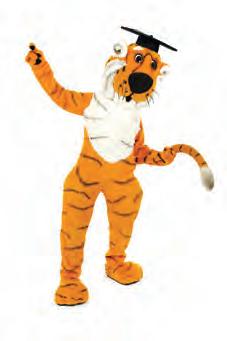
91.3%
201420162018202020222024 2013 16,000 17,000 18,000 19,000 20,000 21,000 22,000 23,000 24,000 25,000 20152017201920212023 GROWTH @ MIZZOU
40% 45% 50% 55% 60% 65% 70% 75% 80%
Graduation Rates Retention Rates
4-Year 5-Year 6-Year 76.0% 73.5% 56.4%
86% 88% 90% 92% 2017201820192020202120222023
30 MIZZOUMAGAZINE
and growing!
2017 2018 2019 2020 2021 2022 2023
A Grant-Fueled Renaissance
Is spring the season of renewal? Undoubtedly. And this spring, a bounty of grants is growing knowledge across the MU campus. Below are some highlights.
TOP CROPS
Rob Myers, an adjunct professor in the College of Agriculture, Food, and Natural Resources, and director of the Center for Regenerative Agriculture, earned $35 million from the U.S. Department of Agriculture. It’s the largest federal research, education and extension grant ever awarded to an MU faculty member. The grant aims to help MU double cover crop acreage in the U.S. by 2030. Myers also secured a five-year USDA National Institute of Food and Agriculture commitment supporting the doubling of cover crop seed production.

SCIENCE AND ARTS



A $20 million Advanced Research Projects Agency for Health grant supports researcher Paul de Figueiredo's project aimed at reducing cancer deaths and enhancing patients' quality of life. Aligned with President Joe Biden's Unity Agenda and Cancer Moonshot goals, de Figueiredo's research integrates technology and biomedical advances to create a singledose treatment stimulating cancer patients' immune systems.
The Walton Family Foundation awarded a $2.4 million grant to expand the Missouri School of Journalism’s Mississippi River Basin Ag and Water Desk collaborative. The desk has developed a team of journalists stationed across the region to explore water, agricultural and environmental stories.

A $300,000 grant from the National Endowment for the Arts supports MU education policy expert Brian Kisida. An assistant professor in the Truman School of Public Affairs, Kisida is establishing a National Endowment for the Arts Research Lab to study the intersection of arts, humanities and civic engagement.

MU’s efforts to develop and improve training videos for childhood care providers and professionals have earned a $7.5 million grant. Mizzou Academy, an online school within the College of Education and Human Development, collaborates with the Missouri Department of Elementary and Secondary Education to make required training more engaging and accessible. M
31 SPRING 2024
BASIN BEAT
CANCER MOONSHOT
KIDS VIDS

THE SILENT INTRUDER
NextGen Precision Health neuroscientist
Smita Saxena explores ALS's insidious path.
Silence is one of the most troubling aspects of amyotrophic lateral sclerosis (ALS).
From the moment patients first notice symptoms of this neurodegenerative disease, also known as Lou Gehrig’s Disease, it takes an average of 10 months to get a diagnosis, according to research. Those 10 months of delay would be a challenge on their own. Over time, early symptoms such as muscle twitching and weakness and difficulty swallowing or speaking begin
to devolve into devastating effects on the body’s motor functions. The disease is ultimately fatal.
But the delay from disease onset to diagnosis is much longer than those few months, says Smita Saxena, a University of Missouri professor and NextGen Precision Health researcher with expertise in cellular neurosciences.
“The disease process is quite insidious and silent,” Saxena says, “so we cannot say, ‘Oh, the disease started the day the patient came to the hospital.
It could have started 20 years or 10 years beforehand.’”
In that silent period before symptoms and diagnosis, the ALS disease process plays out in the body. A specific set of motor neurons may degenerate for years before the first physical signs show up, even while other brain cells function as normal. This phenomenon is called selective neuronal vulnerability, because only one set of neuronal cells is vulnerable to attack. It’s common across neurodegenerative diseases.
Saxena’s research is dedicated to understanding the phenomenon — and ultimately using that understanding not only to detect the disease earlier but also to develop better, more targeted therapies for a community of patients in need.
33 SPRING 2024
STORY BY CHRIS BLOSE, MA ’04 ILLUSTRATION BY GÉRARD DUBOIS
33 MIZZOU SPRING 2024
A Pluripotent Platform
As the crow flies, Bern, Switzerland, is 4,721 miles from Columbia, Missouri. The former is where Saxena built a high-profile career leading her own independent lab. The latter is where Saxena lives and works as of 2024 after being recruited to join NextGen Precision Health, a University of Missouri System-wide initiative staffed by researchers and clinicians.
She first came to the university in May 2023 as part of a series of seminars at the invitation of David Arnold, NextGen’s executive director. It wasn’t a recruitment visit, necessarily, but Saxena liked what she saw and heard.
Drawn to the facilities and equipment at the Roy Blunt NextGen Precision Health building, she was enthused by Arnold’s goal of growing a team of highly motivated neurosciences investigators. She also appreciated the close ties between basic and translational researchers and the doctors and other clinicians who work directly with patients.
“That is what we, the basic researchers, really look for is the liaison with the clinicians and the possibility to quickly move a target from bench to bedside,” Saxena says.
In turn, Arnold knew what Saxena could bring to the initiative. Arnold is a researcher and clinician in the field of ALS and other neurodegenerative diseases who joined NextGen in 2022. Since then, he has helped build a roster of investigators and doctors working on cardiovascular metabolic health, cancer, immunology, reproductive biology, bioengineering, medical imaging, autism and more. He has his own history of bench-tobedside work, too, having been an investigator on a gene therapy for spinal muscular atrophy.
“I was recruited, I think, because of my background of being part of these big teams that really move new therapies to the clinic,” Arnold says. “And really, NextGen Precision Health, the initiative, is all the various parts of my life in one spot — with the goal to break down those barriers that sometimes separate healthcare and science.”
Arnold’s current priority is growth in neurosciences. Recruiting Saxena helps fill a major need for her fellow researchers.
“Probably the biggest gap until she got here is an approach called induced pluripotent stem cells,” Arnold says. “So that’s where you can take a skin cell, and you basically erase the genetic markers of it. You can turn it back into a stem cell, so then you can turn it into a neuron or a muscle cell or any cell like that.”
The value of pluripotent stem cells is hard to overstate. Its effectiveness is like taking a fully written story — potentially one with a bad ending — and turning it back into a blank page, ready to be rewritten however needed.
Researchers can use these flexible cells to model different stages of disease, to see how neurons respond to currently available treatments, and ultimately to work toward treatment to what works best for individual patients. Imagine being able to test a specific therapy on a specific patient, using their very own cells. It’s as precise as precision medicine can get.

An estimated 32,000 people in America live with the disease, according to the CDC, and those numbers are likely underreported. Yet even for a rare disease with a relatively small population, a one-size-fits-all treatment is unlikely to work for every patient.
“Eventually, what we are achieving is a precision medicine which is tailored where we have found, perhaps, molecules that are specifically working on those patients’ neurons,” Saxena says. “My biggest goal here in Missouri is to actually set up these model systems because they are not yet available here.”
Breaking Through Barriers
Saxena divides her research agenda into three parts, based on key questions. The answers have implications for ALS, but also possible applications for other patients, as well. (See “Beyond ALS” on page 35.)
The first, and most basic question: When does the disease really start?
Saxena’s expertise at the cellular level comes into play here. She and her team examine the specific neurons that are affected by ALS, and how they behave and respond. “Our brain is plastic,” says Saxena, referring to the brain’s ability to adjust and adapt, “so the neurons have the capacity very early on to
34 MIZZOUMAGAZINE MIZZOUFORWARD
BEN STEWART

Smita
Imagine being able to test a specific therapy on a specific patient, using their very own cells. It’s as precise as precision medicine can get.
actually resist the onset of disease. And they do this by initiating adaptive or compensatory responses.”
Saxena’s working hypothesis is that once those adaptive responses fail, the disease process begins in earnest. With that in mind, future therapeutics might focus on helping neurons maintain their adaptive responses, and thus their ability to fight ALS.
However, doing so requires a strong understanding of where a patient is in the disease process, which leads to the second question: How can we determine disease stages?
Biomarkers offer one potential answer. Clinicians use these molecules to identify abnormal processes in the body, including disease. “Right now, we don’t have biomarkers that can predict and say, this patient is in stage one, stage two or stage three of the disease,” Saxena says. “So can we find those biomarkers which could enable us to predict where and how far the disease has progressed in this patient?”
Understanding and then staging the disease lead to the ultimate question: What are the best therapies?
Treatments for neurodegenerative diseases often work best when delivered directly to the brain. Therein lies the challenge. Drugs must be able to penetrate the blood-brain barrier, essentially a border that separates the circulatory system and the central nervous system.
“Very often an orally given drug is largely metabolized in the liver and then excreted out. So we work with molecules, like nanolipids, if we have a potential drug target. It’s a quite a complex chemical process, so we work together with biotech companies to do that for us. And then, once we have these nanolipids, they can easily cross the blood-brain barrier. They bring along your target molecule into the brain, and then they can be delivered to the right areas of the brain for therapy.”
For instance, Saxena previously collaborated on research showing that one particular protein, cerebral dopamine neurotrophic factor (CDNF), protects the neurons that are vulnerable in ALS. On top of that, CDNF can pass the brainblood barrier. As a treatment, it’s promising enough that a multicountry collaboration is pushing it into human clinical trials for movement disorders like Parkinson’s disease and ALS. Still, researchers and clinicians alike know that no one drug will solve everything for every patient. The work continues in all phases, from the most basic science to the translational work that takes a discovery from bench to bedside.
“I don’t believe that there will be one single magic bullet,” Saxena says. “This is going to be a combination of therapy. So, we need to find several different therapeutic targets that would work together.” M
BEYOND ALS
When Smita Saxena joined the NextGen Precision Health team this year, she brought her expertise in ALS with her. However, her work, and that of her colleagues, has applications beyond just one disease.
Saxena and David Arnold, executive director of NextGen, shared a couple of other priorities for the growing neurosciences team:
One is applying existing techniques or discoveries to other diseases, since principles such as selective vulnerability apply across the board for neurodegenerative diseases. For example, CDNF, a promising neuroprotective protein that Saxena helped identify as a potential drug target, has possible applications across various neurodegenerative diseases.
The team also focuses on autism now, thanks to a collaborative initiative between the university and the nonprofit Genetic Autism Alliance. The goal is to seek and develop targeted treatments for genetic forms of autism. Saxena’s induced pluripotent stem cells will be especially helpful in this search, because they can be used to test specific therapies on specific cells.
Arnold says Saxena’s cell platform should apply to diseases beyond the nervous system, so it’s a boon for the entirety of NextGen. “It really will have a ripple effect,” he says. “And that’s one requirement of NextGen Precision Health. You are required to collaborate. Team science is a prerequisite to be part of the team.”
Saxena, above, and her team examine the specific neurons that are affected by ALS and how they behave and respond.
SPRING 2024 35
Brandon Boyd’s
Barbican Rhapsody
SINCE SPRING 2020, conductor, composer, pianist and MU professor Brandon Boyd has booked an annual flight to Heathrow Airport. His destination? The illustrious concert hall at London’s Barbican Centre. Once there, Boyd, an associate professor at the School of Music and the Director of Choral Activities, joins forces with the London Symphony Orchestra (LSO) and more than 250 voices drawn from various corners of the London community.
Seated at the piano and guided by the baton of LSO associate conductor Andre J. Thomas, Boyd performs with this storied ensemble in a program featuring a composition he arranged, one that erupts with a heavenly choir and the full power of the orchestra. The combination roars through the iconic venue.
Talking in his office (which has a baby grand piano in it) at the Jeanne and Rex Sinquefield Music Center, Boyd describes, in a reverent tone, the experience of being on stage with what he calls “the best of the best” performing his work. Music born as the seed of an idea blossoms at a packed Barbican.
The LSO and choirs have performed three of his arrangements: “Until I Reach My Home,” “Sign Me Up” and “I’ll Fly Away.” Currently, Boyd is collaborating on the orchestration for his latest piece. Scheduled to premiere at the Barbican on November 5, it’s titled “Come and Go with Me.” Boyd describes it as a Black spiritual rooted in the gospel tradition. He arranged it a few months ago for Tom Trenney as part of a collaboration between First-Plymouth Church and Nebraska Wesleyan University.
Boyd calls the notion of his songs coming to life at the 2,000-seat Barbican a singular thrill, describing it as “a gift from God that I can’t help but to cherish. It’s quite amazing to write or arrange something that starts as an idea and see how it transforms instrumentalists, singers and audiences, taking them to a place I never imagined.”
Stressing that he’s not trying to sound conceited, Boyd describes witnessing the transformative power of music in such a venue as “one of the biggest honors for me, to see the joy that people have from the music birthed by my ancestors — it’s a gift.” M
36 MIZZOUMAGAZINE FACULTY
MU professor harnesses the powers of the London Symphony Orchestra and a chorus of London voices.
Story by Randall Roberts, BA ’88 | Photo by Abbie Lankitus
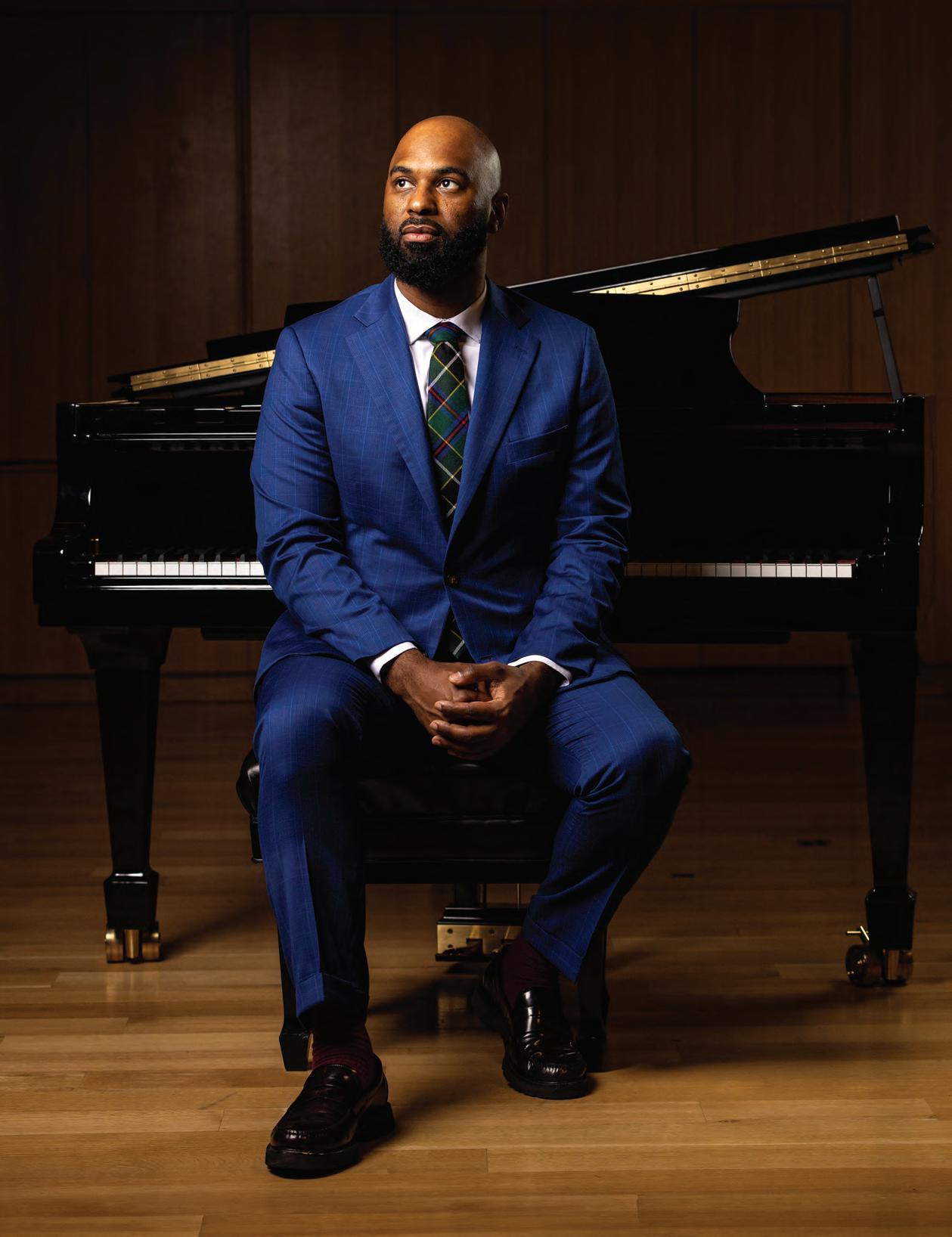


Former Tiger offensive lineman Kurtis Gregory is blocking financial barriers for his constituents — and student athletes — at the Missouri State Capitol.


PROTECT & ADVANCE




 STORY BY TONY REHAGEN, BA, BJ ’01
STORY BY TONY REHAGEN, BA, BJ ’01
38
PHOTO BY ABBIE LANKITUS
MIZZOUMAGAZINE SPRING 2024
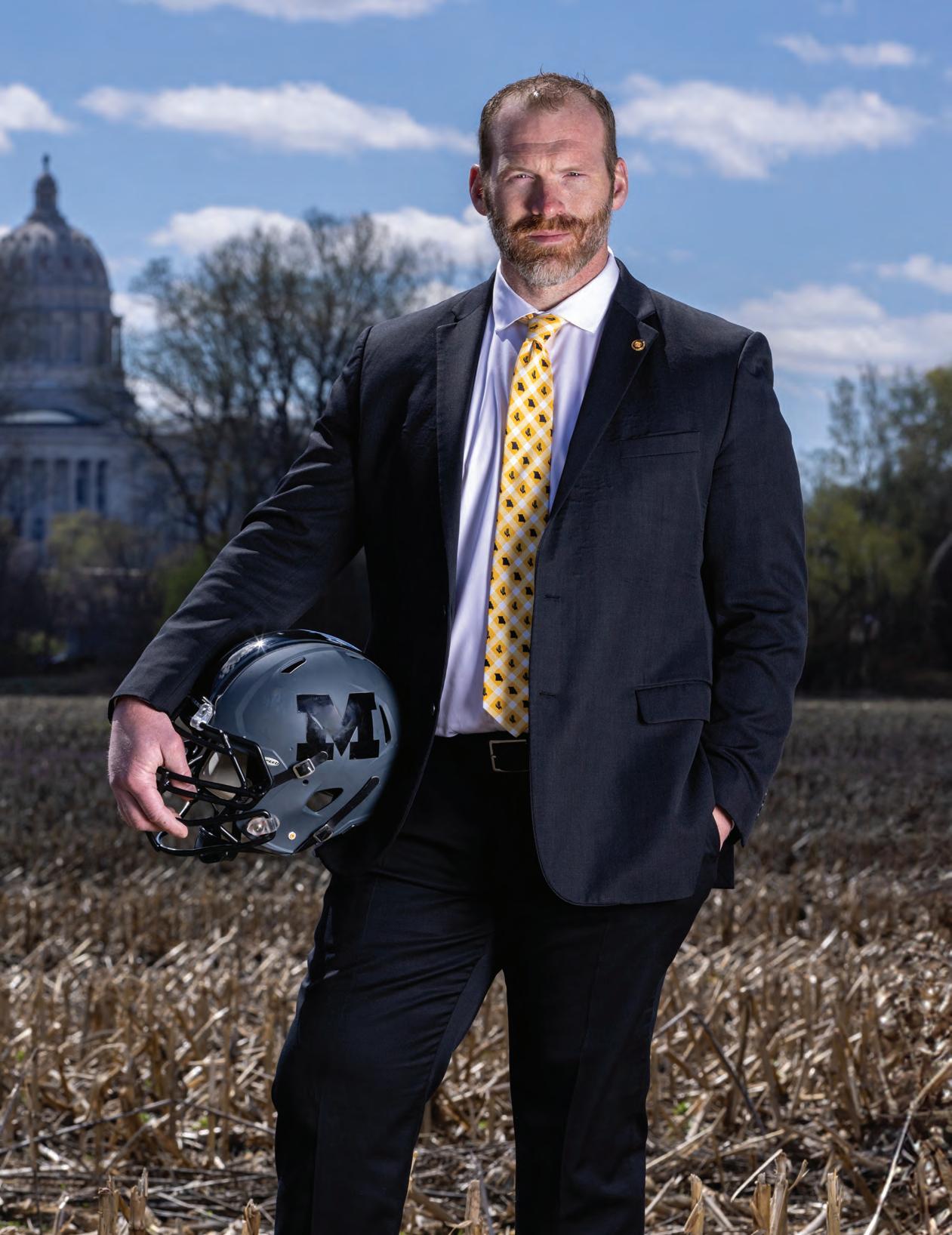
KURTIS GREGORY CUTS AN IMPOSING FIGURE.
Wearing a black suit and a sharp black-andgold tie, his 6-foot-5-inch, 300-pound frame is currently crammed into an office chair in House Hearing Room 1 in the basement of the Missouri State Capitol. When he leans forward over a small table in front of the gallery, he gives the impression of a father sitting at his fourth-grader’s desk at a parent-teacher meeting.
Gregory’s commanding presence isn’t projected solely through his size; it’s also in his face, his intense blue-gray eyes wreathed in a graying red beard with a mouth always slightly upturned in a faint, knowing smile. It’s the stoic countenance of a football offensive lineman, which Gregory was at Mizzou from 2006 to 2009.
But seated here alone today, shoulders squared to face nine of his fellow state representatives, Gregory is on the defensive, a position he finds himself in often in his current role as a legislator. He’s presenting a rural economic development bill that he is sponsoring to the Joint Committee on Rural Community Development.
On pass plays, they protect their team’s quarterback from oncoming defenders. On running plays, they punch holes and clear lanes in the defensive line to allow running backs to advance the ball on foot. That’s basically it: They protect their own and blaze a path forward.
Through his work on NIL, that’s what Gregory believes he’s done for student athletes all over the state — and possibly throughout the country.
NIL aside, Gregory’s roots in the rural Midwest ground his passion on issues that affect small-town Missouri. That’s why he’s bringing the Missouri Rural Access to Capital Act back to the legislature after a similar measure failed to pass last year.
His proud country upbringing also probably explains why, in the hearing, Gregory is crushing the green cap of his water bottle into the shape of a football with his massive thumb and forefinger while respectfully responding to comments from Kansas City and St. Louis legislators. They’re arguing against their constituents’ tax dollars funding less populous parts of the state and wondering what an electric cooperative is.
“When I was in the Ag School, I’d show up to class the first day and the other Ag kids would see me in my gear and say, ‘Oh, you’re just a football player taking an Ag class,’” he says. “No. I’m a farmer who grew up wanting to be a farmer. It’s all I ever wanted to be.”
Dubbed the “Missouri Rural Access to Capital Act,” the bill would essentially incentivize lenders to offer loans to small rural business owners, such as those he represents in Saline and Lafayette Counties, who are otherwise unable to find funding through their banks.
Gregory owns a small family farm. In just two years as a State Representative, he has already made a name for himself by advocating for things he knows, whether it’s farmers or student athletes. He made national headlines last year by spearheading House Bill 417, a 2023 update to the state’s bipartisan name, image, and likeness (NIL) law that made conservative Missouri one of the most progressive states in the union when it comes to compensating amateur student athletes. Gregory’s early success, particularly in NIL, is fueling a run for state Senate in the Republican primary this August.
His arguments about NIL were compelling then and remain so today, especially what he calls “the hypocrisy” of the old way of doing things. Launching into an impassioned, if oft-repeated rant, he notes, “If I had gone to the University of Missouri to play piano, I could still do concerts and get paid, or record and get paid. But Willie Mo [former Mizzou safety William Moore], who was a pretty good rapper, couldn’t put out a song out on Spotify and get paid for it, even though it had nothing to do with his athletic ability.”
In football, an offensive lineman has two jobs.
The subtle but apparent frustration is more than partisanship or resentment stemming from the growing rural-urban divide in America. Gregory also holds a sincere conviction that he knows what he’s talking about, and that what he is doing is right.
“When it comes to rural Missourians, especially anything ag-related, he has a passion for it,” says Tim Barnes, Gregory’s friend and former Tiger teammate. “He knows what it was like 20 years ago when his parents and grandparents farmed. He’s going to do the work. And when he has his facts and lays them out, that’s what he’s going to say and that’s what it’s going to be. It’s coming from a genuine place. He has confidence in what he knows.”
GREGORY DIDN’T PLAY a single snap of football until he was a freshman in high school. He grew up on his family’s soybean and corn farm just outside of Blackburn, Mo., population 230. He learned to drive a tractor in third grade and was cutting crops by himself before he was in junior high.
In 2001, he was an incoming freshman in a driver’s education class in summer school at Santa Fe High School in Alma, Mo., when Mizzou assistant football coach Andy Hill spotted him as he passed the classroom. Gregory, already 6-foot-4 and some 280 pounds, was stuffed behind a tiny school desk. The coach invited Gregory to a one-day Mizzou camp at St. Pius X High School in Kansas City. “When Coach [Bruce] Walker told all the offensive linemen to get in the three-point
40 MIZZOUMAGAZINE PROFILE

stance, I was like ‘I don’t know … what to do,’” Gregory says. “I just tried to do what I saw on TV.”
Eventually, he knew what to do. He got good enough to warrant a scholarship offer from Kansas, interest from the likes of Kansas State, Oklahoma, Iowa, Illinois and Nebraska, and a phone call from defending national champion Louisiana State on behalf of then-coach Nick Saban. But there was only one place he wanted to play — close to home, to his farm and his family, for the coaches who had first seen something in him. He protected Chase Daniel and Blaine Gabbert and blocked for Tony Temple and Derrick Washington during an unprecedented run of success for Coach Gary Pinkel’s Tigers, which included the team’s first No. 1 national ranking since 1960.
Despite the success on the gridiron, his heart was always planted in a different type of field. He majored in agriculture. “When I was in the Ag School, I’d show up to class the first day and the other Ag kids would see me in my gear and say, ‘Oh, you’re just a football player taking an Ag class,’” he says. “No. I’m a farmer who grew up wanting to be a farmer. It’s all I ever wanted to be.”
Gregory sometimes brought his teammates, including tight end and San Diego native John Gissinger and quarterback Daniel, home to the farm, where they went to cattle auctions, shot .22s, and even learned the workings of a hay rake and baler. One summer, he, Barnes and Elvis Fisher

were working on a nearby farm, where the owner wanted them to work up the field a certain way. “After the owner left, Kurtis told me, ‘Nope. That’s the wrong way, here’s how we’re going to do it,’” says Barnes. “Then we had to hear about it from the owner.”
IN THOSE DAYS, players had to be careful about the work they did, particularly if and how they were paid for it. The NCAA had strict rules about amateur athletes not accepting compensation for
Top: State Representative Kurtis Gregory made national headlines last year by spearheading House Bill 417, an update to Missouri's bipartisan name, image and likeness (NIL) law. Bottom: Gregory and 2009 teammate Sean Weatherspoon admire the Telephone Trophy, which is awarded to the winner of the Mizzou and Iowa State game.
41 SPRING 2024
TOP: TIM BOMMEL, MISSOURI HOUSE OF REPRESENTATIVES; BOTTOM: JOHN SCHREIBER/ MISSOURIAN

“There’s so much money flowing into college athletics with these TV contracts, I just don’t see an issue with players trying to capitalize. If I could have made $250,000 while I was playing, would I have even tried in the NFL when I knew my body was messed up? I might not have.”
certain things. While any other student was free to make a living, student athletes couldn’t accept a free cheeseburger from a donor.
Meanwhile, the schools and athletic conferences were making millions of dollars on TV rights and merch sales. “We’re selling No. 10 jerseys in the Tiger Team Store for $100 a pop, and everyone and their brother knows that’s a Chase Daniel jersey,” Gregory says. “Why shouldn’t he be allowed to get a royalty off it just because it doesn’t say ‘Daniel’ on it? If he wasn’t doing well, that jersey wouldn’t be selling.”
Gregory graduated with a bachelor’s degree in agriculture management in 2008 and got his master’s in Dec. 2009. After a brief stint with the NFL’s Carolina Panthers, the toll the game had taken on his body, including six surgeries, led him to hang up the helmet. His first job was driving a grain cart on a nearby farm, which led to work selling seed.
He was recruited by the Missouri Corn Growers Association for their inaugural CornRoots Leadership Academy and eventually earned a spot on their board. That’s when Gregory got his first itch for politics. “That role taught me how to tell my story, the story of Missouri farmers,” he says. “It taught me that if you’re not telling your story, then the politicos in Jefferson City would make up their own minds.”
The Corn Growers gig eventually called for Gregory to travel the country, something he wasn’t keen on doing. He returned to Blackburn to help his folks run the farm. But he missed being involved and was concerned to see fulltime farmers, still a significant contributor to the statewide economy, so underrepresented in Jefferson City. In 2020, he ran for and won the vacant seat in District 51.
Gregory expected to be fighting for issues traditionally important to his rural constituents, like lower taxes and limited government regulations, when he decided to run in 2019. He had no idea
that he’d be leading legislation on vaccine mandates, transgender participation in high-school athletics, and compensation for college student athletes. But after settling into office, he saw an opportunity to build on Missouri’s 2021 NIL bill.
“There’s so much money flowing into college athletics with these TV contracts, I just don’t see an issue with players trying to capitalize,” Gregory says. “If I could have made $250,000 while I was playing, would I have even tried in the NFL when I knew my body was messed up? I might not have. This gives players the ability, while they are a known commodity somewhere, to make some money to put away or set them up for the rest of their life.”
IN
2019, CALIFORNIA BECAME the first state to pass a law enabling student athletes to monetize NIL in everything from jersey sales to local TV ads for car dealerships. Several more states quickly followed suit, with some restricting endorsements from businesses in alcohol or sports gambling. But the message was clear: While schools still could not be seen to be paying players to play, states were going to have to empower students to be compensated for commercial use of their name, image or likeness if they had any hopes of competing for top recruits.
Missouri’s initial 2021 law was fairly boilerplate. It allowed student athletes to enter endorsement deals with businesses and market themselves to companies and even directly to would-be consumers. But in 2023, Gregory co-authored provisions that, among other things, allowed high-school athletes to take endorsement money before they arrive on campus — as long as they signed with an in-state college. It also empowered college coaches and school officials to connect these recruits with NIL opportunities and even help them negotiate.
Critics say the measure puts Missouri on the brink of schools directly paying players to come; proponents counter that it is essential to help the state compete in the interstate arms race for recruiting that NIL has become.
For his part, Gregory doesn’t see this as a partisan issue. In fact, he says he has trouble convincing some in his own party, let alone those across the aisle, about the statewide benefits of NIL. To him, it’s part of a larger duty to safeguard not just his fellow student athletes, but also the other students and the institution itself.
In other words, Gregory sees his task as that of protecting and advancing the interests of his alma mater — and student athletes in colleges all over the state. M
42 MIZZOUMAGAZINE
PROFILE
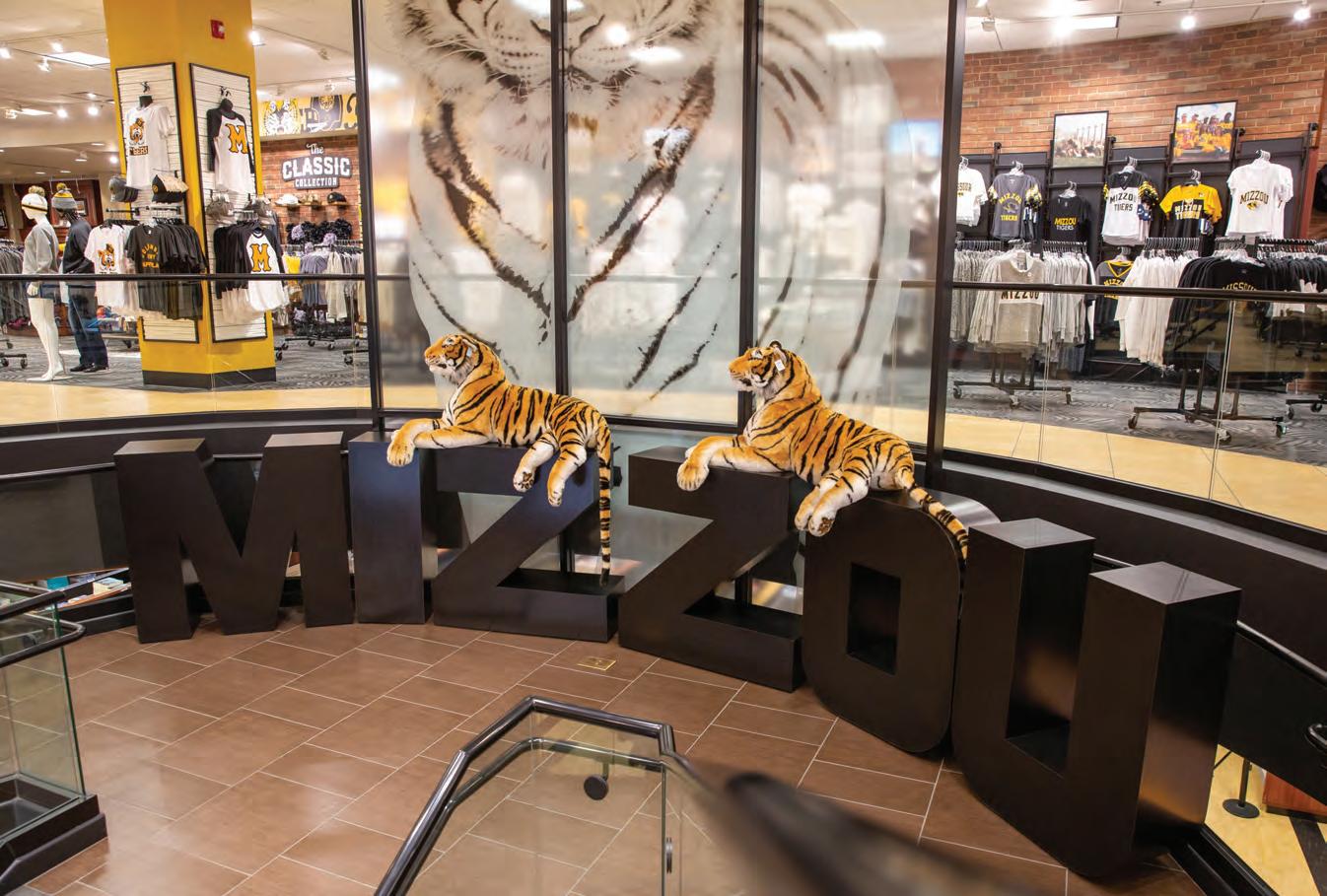







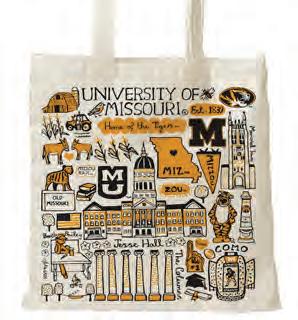
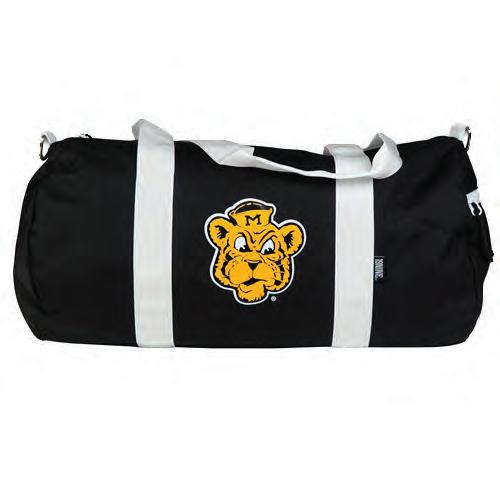





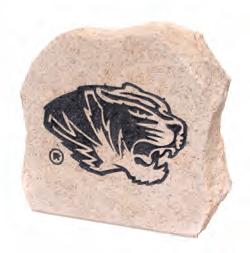
43 SPRING 2024 The Mizzou Store is owned and operated by the University of Missouri. Every purchase you make at The Mizzou Store supports students, faculty, staff and campus initiatives. ALUMNI ASSOCIATION MEMBERS SAVE *Valid on Mizzou gear & gifts. Exclusions apply. Not applicable to tech. Cannot be combined with other offers. 10% EVERYDAY! Showcase your TIGER PRIDE with the latest Mizzou merchandise OfficialTiger Outfitters
THE MIZZOU ALUMNI ASSOCIATION
WELCOMES
2023’S NEW LIFE MEMBERS
Mark Abbott
Christopher Abel
David Adair
Cooper Adams
Joyce Anne Airaghi
Jack Akers
Janet Akremi, M.D.
Benjamin Albertson
Roy Aldaba
Genalee Ann Alexander
Arthur Allen
Carla Allen, Ph.D.
Erin Allen
Houshang Almassi
Joan Anderson
Alexander Anderson
Rosalyn Anderson-Harper
Paul Andre
Cullen Andrews
Teresa Shay Arms
Ben Arnet
Nicole Arnet
Nick Arnold, M.D.
Dr. Shirley Arnold
Phillip Arnzen
Lisa Aslin
Braden Ast
Robert Atcher, Ph.D., MBA
Briauna Azan-Loesing
Johanna Carolina Bailey
Ryan Bailey
James Baker
Raellen Baker
Rebecca Baker
Madison Baker
Lauren Ball
Brian Banks
Billie Banks
Michelle Renee Barbeau
Adam Barklage
Max Sherwood Barnett
Tracy Rolf Bartels
Dr. Gail Bass Derscheid
David Lance Baty
Dr. Karin Elizabeth Baughman
John Charles Baughman
Nathaniel Patrick Beattie
Hope Beitchman
Grace Mae Bellovich
Lara Benson
Philip Bergman
Sarah Bergman
Emily Besgrove
Olivia Besgrove
Brenda Beshears, Ph.D.
Larry Lydel Bezold
Loretta Diane Bezold
Adam Bien
Dr. Becky Bien
Elizabeth Wellborn Bier
Jacob Biever
Bill Bishop III
Brenda Blankenship
Richard Blankenship
Jeffrey Blattner
Chad Blomberg
Kristin Blomberg
Aarika Bock
Bryce Bock
Maelisha Boclair
Erin Picard Boeckman
Philip Boeckman
Hal Boedeker
Joshua Boehm
David Bonham
Ginny Booker
Michael Bossert
Cassie Brandt
Mark Braun
Eric Braverman, JD, CPCU
Kelly Anne Brenner
Laurie Brickey
Leroy Brinkman
Stephen Brooks
Charles Brown, Jr.
Julie Richardson Brown
Contessa Brundridge
Mark Buehler
Ross Buehre
Brent Buerck
George Bukaty
Grant Bunch
Michael Jay Burbank
Sara Burbank
Mason Conrad Burch
Frederick Burke
Dana Burke
Charlotte Burkett
Bradley Burns
Byron Burns
Stanley Burns, M.D.
Laura Bush
Cynthia Buttress
Jerry Buttress
R. Randall Canent
Chuck Cantor
Sandra Miller Cantor
Jean Marie Carey
Deborah Jean Carey
Mya Anne Carlton
Carli Moser
Carmack
Stephen Carson
Anne Casey
Jessica Casey
Nancy Chambers
Krista Chassee
David Chervitz
Robin Lynn Chervitz
Carla Chitwood
Robert Chitwood
Myong Ja Cho, Ph.D.
Mae Beth Chott
Hei-Mei Chow
Melanie Renee Clark
Donna Clithero
Philip Clithero
James Coday
Adam Cohen
Rachel Coker
Randell Collins
Darby Ann Collins
Jennifer Seeker Conroy
Tracy Cook
Cynthia Ann Cook-Grumney
Izabelle Cool
Krystin Cooper
Rebecca Lynn Cooper
Rebecca Rae Cooper
Chip Cooper
Jane Cooper
Jennifer Bryte Cooper
Todd Cooper, M.D.
Benjamin Copeland
Morgan Corder
Jeff Corrigan
Carol Coulter
Eugene Coulter
Robert Cox, Jr.
Katherine Cox-Littrell
Aarah Craig, D.V.M.
Derek Craig, D.V.M.
Elena Andree Crain
David Cravens, M.D.
Ashley Lauren Crisp, M.D.
Lana Cristiani
David Culp
Jeremy Michael Culver
Justa Dahl
Stacey Darbro
D. Neal Davidson
Matt Davidson
Michael Davis
Samantha Jean Davis
John Davis
Dawn Robinett Davis, M.D.
John Davis, M.D.
Grant Davis
Marianna Rowe Deal
Louis DeGuentz
Fred Dehner
Ashlynne Nicole Dempsey
Kimberly Anne Derucki
Joseph Dino
Ronald Dobey, Jr.
Tarilyn Dobey
Bradley Doerhoff
Jenna Doerhoff
Cylee Gye Drake
Lucy Dreiling
Brin Megan Driscoll
Brian Dunleavy
Kristin Dunlop
Kevin Henry Dunn
Eric Thomas Durban
Savannah Brooke Durban
Megan Lynn Edwards
Jacob Dakota Edwards
Glen Ehrhardt
Gary Eickhorst
Parker Eimers
Janet Elliott
Brad Erickson
Becky Ericson
Matthew Ericson
Lyndsey Ernat
Morgan Elizabeth Erutti
Kyle Ervin
Stacey Charles Evans
Charles Samuel Evans, Ph.D.
Mary Amelia Evans, Ed.D.
Margaret Evers
Andrew Fansher
Robert Felberbaum
Audrey Feuerbacher
James Feuerbacher
Gregory Ficken
Teresa Ficken
Brian Filbert
Charles Finder
Mark Gerard Finke
Danielle Nicole Fischer
Mark Fitzpatrick
Nancy Fitzpatrick
Kathryn Fleming
Matthew Fleming
Kevin Fletcher
Peter Flora
Bethany Buckingham Follett
Samantha Fomera
Tonya Ford
Melissa Ford
Kelsey Forqueran
David Paul Forward
Patricia Forward
Joanne Mary Fox
Jackson Franklin
Stephanie Franquinha
Stephen Wesley Frayn
John Cody Frederick
Jared Sam Freed
Anne Freeman
Brad Fresenburg, Ph.D.
Carol Marie Frey
Mel Frieders
Jennifer Friedman
Aly Friend
Kristin Frogge
Jason Michael Frost
Brendan Funesti
Susan Gale
44 MIZZOUMAGAZINE
Raul Galoppe, Ph.D.
Deborah Garton
Dr. Bryan Garton
Benjamin Gaus
Hannah Gay
Sarah Geear
Zachary Tyler Geear
Kyle Gerding
Brynden Gibbens
Kate Gibbs
Jack Thomas Gieseking
Timothy Gilbert
Debra Gill
Audrey Gillum
Joshua Gilmore
Glenn David Gilyot
Dr. Justin Glisan
Maggie Glisan
M. Shane Glor
Mark Godich
Linda Godwin, Ph.D.
Daniel Goellner
Susan Goellner
Erin Goff
Hailey Gold
Mark Goldinger
Miguel Gonzalez
Dr. Jennifer Lyn Good
Michael Goodwin
Monica Goodwin
Lani Gordon
Brian Grabowski
Dr. Julie Ann Graham
Frederick Suhr Grant
Michael Graves
Richard Greenup
Tammy Greenup
George Patrick Greenwell
Laura Power Greenwell
Katelyn Lea Gresko
Debora Grewach
Edward Grewach
Jeanne Grier, Ph.D.
Joel Grindstaff
James Edwin Grisham
Faith Groenke
Cynthia Van Leer Groenke
Nealey Grosdidier
Dustin Gross
Dr. Paige Gruenke
Nelson Grumney, Jr.
William Gullic
Janet Guthrie
Michael James Hackworth
Amy Elizabeth Hadfield
Timothy Hadfield, Ed.D.
Dominic Haertling, M.D.
Amanda Haesemeier
Jeremy Haesemeier
Tyler Jackson Hagan
Farilyn Beth Hale
Erin Kelly Halka
Catherine Hall
Larry Halliburton, Ph.D.
Deborah Hamler
Virginia Nelson Hammerle
Morgan Hanley
Mackenzie Hard
John Harper
Heather Elizabeth Harper
Robert Harris
Kyle Harris
Ashlie Hart
Gavin Hart
Kaycee Hart
Mark Hartnagel
Denise Muensterman
Harvey, O.D.
Mark Edward Harvey
John Haskins
Laura Ellen Hawkins
Sara Hawthorne
Carolyn Heger
John Heisler III
Adam Heitman
Jessica Wynne Heitman
Lynn Ann Helmsteadt
Christopher Hemeyer
Alfredo Isaias Hernandez
Brendan Paul Heslin
Jorgen Hesselberg
Mark Hewlett, D.M.D.
Rodd Hillard, M.D.
Bill Hines-McLain
Mary Hininger
Donna Prentice Hoban, Ph.D.
Michael Hoban
Catherine Hoeller
Michael Hoeman, M.D.
Nancy Skoglund Hoeman
David Gene Hoeman
Mary Anne Hoeman
Jaime Lynette Hoener
Joshua Hoener, Ed.D.
Jon Hoff
John Holbert
Allison Hollenbeck, Ph.D.
Jessica Holliday
Zachary Holliday, M.D.
John Chadwick Holloway
Eric Holm
Barbara Jean Holmberg
James Holmberg, Jr.
Teresa Lynn Homan, M.D.
Conner Joseph Hood
Grant Hopkins
Nicholas Hopkins, M.D.
Gregory Horstmeier
John Howard
Jean Howell
Dan Hoxworth
Emily Hoyt
Gary Scott Huckstep
Ramona Huckstep, M.S., M.P.A.
Diane Huff
Adam Hughes
Leslie Ann Hummel
Paul Andrew Hummel
Katherine Hunter
Mike Hutchison
Lucia Isman
David Isom
Gretchen Ivy
Kirk Hessel Ivy
Jerri John
Dr. Karey Ann Johnson
Lindsey Johnson
McClane Johnson
Robert Johnson
Marcus Johnson
Maggie Johnson
Sidney Johnson, Ed.D.
Michael Jones
Anna McKie Jones
Douglas Jones
Shane Earl Jordan
Eileen Elizabeth Joyce
Trey Kaiser
Bill Kamler
Landon Keele
Karen Keller-Boyne, Ed.D.
Janet Kelley
Tyger Kelley
Julia Corcoran Kertz Grant
Stephen Miles King
Carolyn King
Marcus King
Anthony King
Nicole King
Emily Nicole King
Ricky Houston Kleager
Karl Kleinbeck
Maggie Klonsky
Ronald Anthony Klote
James Knowlton
Adam James Koenig
Samuel Joseph Koenig
Russell Koester
Robert Kohlman
Erin Kolks
Jason Kolks
Ann Dierking Kopp
John Korschgen
Kim Korschgen
Emily Krase
Jennifer Krause, M.D.
Matthew Krause
Durrell Kreisher
Tina Kreisher
Jake Kretsinger
Lawrence Kriegshauser, M.D.
Katharine Rose Krippner
Shelby Kroenke
Brynna Krough-Deaton
Sharon Kay Krumm, Ph.D., R.N.
Abbey Nichole Kussman
Sarah Grace D Kutter
Nicholas Bret Kutz
Justin LaBelle
Rachel LaBelle
Don Laffoon
Lynn Dudley Laffoon
Jacob Stanton LaGesse
Jonathan Duval LaHue
Jake Lalumandier
Jason Lamb
Vanessa Lamb
Cynthia Lambrick
H. Bruce Lammers, Ph.D.
Dean Lampman
Stephanie Landwehr
Anne Courtney LaRue
Sommer Lassiter
Daniel LaValley
Melanie Lawrence
Scott Justin Lawrence
Leanna Lawrence
Sarah Layton
James Colin Leach
Michael Leahy
Thomas Lee
William August Lee
Christopher LeGrand
Dr. Lisa Lenoir
Dwight Leonard
Sherri Leonard
Anne Reed Leonardo
Fred LeSieur
Mary Leuci, Ed.D.
Victor Leuci, Ph.D.
Janis Levsen
Matthew Levsen
Ryan Levy
Katherine Lewis
Brett Lewis
Mary Ann Lewis
Brian Lewis
Kaylee Nicole Lewis
Cam Linn
Rachel Linn
Taylor Adelaide Lionberger
Devon Marie Loerch
Zach Loesing
Linda Finley Loman
William Morgan Long
Gary Lowe
Evelyn Sender Lowenthal
James Lowery
Mila Lowry
Scott Reed Lucas
Gerard Lucas
Loren Lumpe
Aidan Joseph Lurtz
Janelle Marie Madsen
Nancy Ann Magee
William Daniel Magee, Jr.
Ryan Maher
Ruth Ann Mallory
Steven Mallory
Christopher Maloney, M.D., Ph.D.
Kathryn Markovich
Colin Marks
Benjamin Vernon Marquart
Turf Martin
JoAnn Fleischmann Martin
Steven Martin
Mary Elaine Martin
Holly Martinez
Terry Martinez
Elizabeth Marty
Jeremy Maskel
Edward Matheny, Jr.
Molly Mathews
Daniel Matter
Chase Matteson
Kyle Mauzey
Ryan Mauzey
Marsha Ann Mauzey
Andrew May
Joy Angelica Mazur
Charles McCarthy, Ph.D.
Marsha Kay McClanahan
45 SPRING 2024
Kaiden McCormick
Holly McCoy
Angie Holsinger McDaniel
Grant McDonnell
Zachary McDowell
Becky McElduff
Jeremy McElduff
Ryan McElvain
Rhonda McGuff
Jonathan McPheeters
Dr. Regina McWilliams
Annulet Medlock
David Otis Medlock
Greg Meier
Lesley Meier
Matthew Melton
Toni Rose Messina
Anna Elizabeth Metzger
Madeline Meystrik
Madalyn Michael
Jeffrey Miller
Donald Carl Miller
Dr. Charlotte Miller
Jordan Miller
Nick Miller
Joseph Wayne Miller
Sandra Lynn Miller
Steven Robert Miller
Bruce Mills
Kathryn Miluski, D.V.M.
Fred Mitchell III
Tony Moellman
Barbara Moll
Bradley Moll
Dale Mondary
Danette Mondary
Paulette Harman Monzyk
Stephanie Moore
Casey Morell
Laura Morris, M.D.
Pamela Morris
Marlin Mosby, Jr.
Aaron Mott
Andrew Mott
Sylvia Mott
Austin Mouse
Kaitlyn Mouse, D.V.M.
Jason Mudd
Joseph Muelleman
James Muench
Colin Murphy
Sierra Michelle Murray
Carrie Murray
John Mutz
Autumn Myers
Zaven Dikran Nalbandian
Zaven Nalbandian
Ambrose Nathe, Ed.D.
Janice Neal
Jade Kristine Neeley
Louis Nelen, Ph.D.
Corey Nelson
Leslie Neuman, M.D.
Eryca Neville, Ph.D.
Zane Nichols
Robin Kristin Nichols
Drew Nichols
Steven Niemeyer
Amanda Nilges
John Robert Nilges
Jennifer Anne Nolan
Adam Norton
Mackenzie Anne Norton
Mary Oades
Kelsey Okruch, Ph.D.
David Reese Olson, M.D.
Joan O’Neal
Ryan Orf
Nicholas Osgood
Alexandria Otis, Ed.D.
Aaron Otte
Allison Owen
Michael Owens
Christopher Andrew Parmley
Jordan Parshall
Brittney Patton
Kara Deonne Paulding
Rickey Paulding, Jr.
Ann Kathryn Paulus
David Payne
Edward Peak
Dionne Peeples-Jones
Lexy Perdomo
Valerie Peters
Eric Peterson, Ph.D.
Jessica Lee Peuterbaugh
Lukas Pfitzinger
Clay Phillips
Jacob Phillips
Frank Karl Piburn, PE
Whitney Pierce
Pragash Pillai
Todd Pistolis
David Poe
Robert Polk
Rhea Pookulangara
Maya Porter
Bobbi Sue Potashnick
Larry Potashnick
Van Mitchell Pounds
Braden Powelson
Nicholas Preston
Charles Pride
Zachary Alexander Quinlan
Dr. Maureen Rabbitte
Danielle Ragusky
David Ramseur
Briana Ann Randolph
Brenda Boyd Raney
Jamie Rankin
Hannah Ratermann
Michael Ratliff
Teresa Louise Ratliff
Emily Rau
Julie Reihsen, M.D.
Kelley Reiss
Max Reiss
Susie Rendlen
The Honorable C. E. Rendlen
III
Constance Renton
Jeniffer Reyes
Danielle Reynolds
Gregory Richardson
Kylene Richardson
Alexandra Rickart
Tyler Scott Riechmann
Jason Riley
Sara Riley
Raegan Rinchiuso
Owen Andrew Risse
Ray Robbins, Jr.
Greg Roberts
Dotta Shell Roberts
Thomas Robinson
Spencer Robinson
Elizabeth Loan Robison
Robert Robison, Jr.
Thu-Thuy Thi Rogers
John Romano
Valerie Rene Rone, M.D.
Amanda Roninger
Jenna Michele Rood
David Rotert
Joanne Rotert
Russana Rowles
Amber Hensley Rowson
Scott Rowson
Sharon Rudolph
Mary Janet Ruff
Matthew Rylands Salcena
Janet Sanders
Nora Maynell Sandquist
Zane Elline Sartin
Kamilla Lauren Sarvestani
Maia Satera-Olson
Richard Schaefer
Drew Scheer
Veronica Marie Scheurich
Jennifer Schmitz
Ryan Schnitker
Andrew Schoendienst
Emily Judith Schoenig
Nicole Schoenig
Jennifer Schott
Kyle Schroer
Derek Schuld
Truman Schulte
Chauncy Scott
Sheri Scott
Dr. Donna Senciboy
Rita Shapiro
Jayde Nykole Sharp
Dolores Shearon
Arlesa Shephard, Ph.D.
William Charles Sheridan
Mason Alexander Sherwood
Megan Shroff
Daniel Shydler
Carol Siem
Robert Siem
John Silva
Carol Simon
Larry Simon
Patricia Paterson Skinner
Diana Slater
Adam Slayton
Garry Sloan
William Slusher
Jeffrey Smith
Jill Smith
Mallory Mott
Gilbert Smith, M.D.
Capt. Richard Smith
Raven Smith
Daniel Perry Smith
Stephanie Smith
Lisa Ann Smith
Russell Smith, M.D.
Ryan Smith
Kelly Smith, D.V.M.
Bruce Smith
Christina Smith
Thomas Soell
Shanna Rose South
Anna Lynn Spitzer
Jerry Springfield, Ph.D.
Audrey Stanard
Madeline Stecher
Dennis Stephens
Quentin Stevenson
John William Stewart
Judith Ann Stewart
Victoria Stokes
Amy Stone
Kade Austin Stowell
Erik Joseph Stratman, M.D.
Olivia Grace Struttmann
Dr. Steve Sutton
Joyce Knehans Swanke
Kaleem Syed, M.D.
Linda Syrcle
Thomas Tafoya
Akehiko Takahashi
Denise Taylor
Fred Akpochafo Tega, M.D.
Carter Templeton
Caitlin Marie Teson
Joshua Thibert
Angie Thomas
Fred Thomas
Madison P Thompson
James Thornton
Julianne Thornton
Trenton Thurmon
Richard Tiemeyer
Christopher Timmerman
Elizabeth Timmerman
Patrick Robert Tolley
Patricia Ann Treat
Kelvin Lee Triplett
Zian Trober
Jeffrey Trower
Patrick Tsay
Shu-Hsien Tsay, Ph.D.
C. Bradley Tuck
Donna Turnbo
Beverly Twellman
Ralph Twellman
Dr. Jaret Tyler
Aimee Ujka
Ann Vacek
Mary Tuck VanDyne
Bridget Vani
Joseph Vanover
Ronald Verrilli
Jill Robison Villasana
Matthew Villasana
Rebecca Vincent
Delanie Vinzant
Lawrence Vogt
Evan Vollbracht
46 MIZZOUMAGAZINE
Dr. Christina Vollrath
Kelley Vonarx
Krishna Hemanth Vuppala
Crystal Wagner
Jason Wagner, M.D.
Katie Lynn Wagner
Bobby Waldrup
John Walker
William Wall
Emma Wallace
David Wallinga
Kelvin Walls, M.D.
Dayou Wang, Ph.D.
Xiaomei Wang, Ph.D.
Kyler Watson
Emma Watson
Cary Reed Weatherby
Erin Webber
Dr. Duane Wegener
Laura Joan Wegener
Chris Weiss
Lesa Weiss
Colby Welch
Evelyn Welch
Debra Lynne Wellborn
Luke Austin Wendel
Cheryl Overton Wendling
Stephen Wendling
Abigail Werner
Jeanine Vasel Wescott
Kathleen Wessler
Susan Keuss White
Edward Whitehead
Patti Whitehead
Michael Whitlock
Matthew Alan Whittington
Corey Wiemann
Kelly Wiemann
Gary Wilberg
LeAnne Wilkerson
Sylvia Louise Williams
Sally Williams
Amanda Fales-Williams, D.V.M.
William James Williams, D.V.M.
Mackenzie Williams Howard
Brian Willott
Eric Wilson
Loreli Wilson
Robert Michael Wilson
Caliena Dawn Wilson
Thomas Wilson
Keith Wilson
Alvin Wilson
Virginia Wirtz
Robert Wise
Matthew James Wixsom
Myra Rosskopf Wolfe
John Wolken
Cameron Woodin
Adam Woodward
Elizabeth Worley
William Worley, D.V.M.
Jim Wren, Jr.
Sedda Wuller
Katherine Wyman
Karlin Yaeger
Nancy Yaeger
Dr. Kristen Yates-Booth
Jeffrey Keven Yelton, Ph.D.
Saemin Yoon
Allison Smith Youngblood
Daphne Yu
David Zeeck
Brooke Zeleny
Brian Ray Zerr
Julie Zerr
Karl Zinke
Lori Embree Zinke
Upgrade to a Life Membership today!
Our life members support our University and preserve its great traditions for generations to come. Upgrade today to become a permanent member of the Mizzou Alumni Association! Recent graduates and Tigers over 65+ qualify for a special discounted rate.




47 SPRING 2024
mizzou.com/life or 573-882-6611 Gift your 2024 graduate a Life Membership to the Mizzou Alumni Association! Order by April 30 for an exclusive Class of 2024 8x10 framable art print, along with a greeting card for easy gifting at graduation. Mizzou.com/GradGift 573-882-6611 | maa@mizzou.com
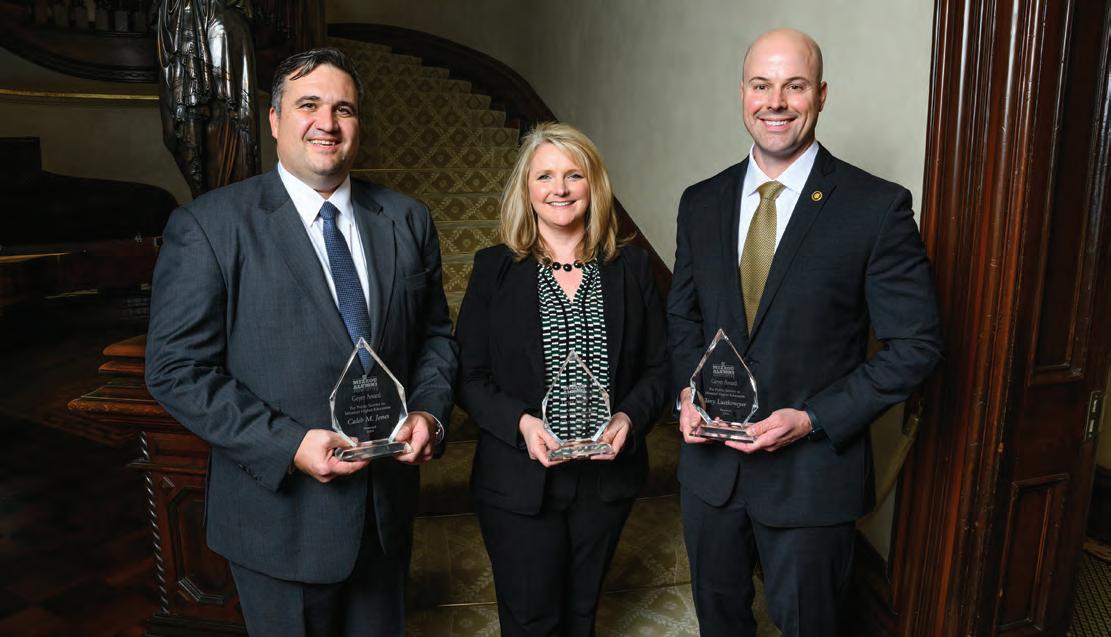
Leading with Purpose
The Mizzou Alumni Association (MAA) is proud to announce the recipients of the 2024 Henry S. Geyer Award. Each year, the MAA presents the award to those who exemplify the dedication and spirit of Henry S. Geyer, a state representative from St. Louis who believed education was the key to progress and prosperity in Missouri. Geyer introduced a bill to establish the University of Missouri in 1839.
Chris Chinn became director of the Missouri Department of Agriculture in January 2017. With more than 15 years of leadership experience in agriculture at local, state and national levels, she advocates for the industry through legislative efforts, social media engagement and sharing insights as a fifth-generation farmer. Collaborating with Governor Mike Parson and cabinet members, Chinn prioritizes agricultural development and infrastructure initiatives, including job creation and infrastructure maintenance. She strongly supports the University of Missouri College of Agriculture, Food and Natural Resources, where she serves on the dean’s advisory council. She resides on her family’s farm in Shelby County with her husband, Kevin, and their children, Rachelle and Conner.
Caleb Jones serves as the executive vice president and CEO of Missouri Electric Cooperatives. Jones has a distinguished background including roles as a former presidential appointee, congressional staffer and three-term Missouri State Representative for the 50th District. During his legislative tenure, Jones significantly boosted core funding for the
university and secured support for various projects such as the new MU School of Medicine and Sinclair School of Nursing buildings, as well as initiatives including the Missouri Kidney Program and the Thompson Center for Autism and Neurodevelopment. As CEO, Jones strengthens university ties through partnerships such as the Mizzou Youth Experience and MU Extension and facilitates access to Mizzou sporting events. He and his wife, Lindsey (BS ’10), live in Boone County with their children, Maxwell and Charleston.
and
Geyer, a state representative from St. Louis.
Senator Tony Luetkemeyer has represented Missouri’s 34th District since 2019 and was reelected for a second term in 2022. He chairs the Judiciary and Civil and Criminal Jurisprudence Committee and serves as vice-chairman of the Appropriations Committee. Luetkemeyer’s dedication to the University of Missouri (MU) began as a student, where he served as the student representative to the Board of Curators and president of the Missouri Students Association. In office, he strongly advocates for the University of Missouri System and the Columbia campus and notably supports the NextGen MURR initiative. This initiative aims to construct a larger research reactor at MU to enhance cancer research and medical isotope production. He and his wife, Lucinda, reside in Parkville, Missouri, and enjoy outdoor activities with their dog, Truman.
48 MIZZOUMAGAZINE MIZZOU ALUMNI NEWS H MIZZOU ALUMNI ASSOCIATION ANNUAL MEMBER | HH LIFE MEMBER
SCOTT SCHAEFER
The recipients of the 2024 Henry S. Geyer Award, from left: Caleb Jones, Chris Chinn and Tony Luetkmeyer. Each year, the MAA presents the award to those who exemplify the dedication
spirit of Henry S.

Momentous Mizzou Momentum
“Victory belongs to the most persevering,” Napoleon famously declared. Given recent University of Missouri achievements, the notion strikes a deep chord in 2024. We ended the year with a grand Mizzou celebration in Arlington, Texas, one worthy of a Texas-sized Tiger Tailgate party and a Cotton Bowl win over Ohio State. The wave of Mizzou pride from that momentous day still lingers!
You can delve into the details of MU’s winning streak and cascade of good news in this issue. The successes are a testament to the unwavering commitment of our students, faculty, staff, alumni and supporters as we celebrate upticks in research grants, enrollment and student achievements. When word spread a few months ago that we’d tallied a record number of applicants for the incoming fall 2024 class, more than 700 alumni stepped up and sent personal congratulatory notes to each prospective student. We’re one of the few major universities who so successfully scales personalized alumni outreach.
Through determination and strategic planning, the university’s research projects have expanded, with expenditures surging by 75% since 2015. This growth benefits not just the university but also the whole state. Mizzou’s contributions deliver nearly 50,000 jobs, $281 million in state and local taxes and almost $1 billion in research output.
Those numbers are worth celebrating. Oh, and let’s not forget Marching Mizzou’s triumphant journey to Ireland, where it was named Best Overall Band at Dublin’s St. Patrick’s Day Festival Parade. Or the Tiger chess team, which recently won the Pan-American Intercollegiate Championship for the first time in the event’s 78-year history.
I’m so grateful for your continued support of Mizzou through your membership in the Mizzou Alumni Association, and we have an impressive roster of new life members to celebrate on pages 44–47! I encourage you to absorb stories about your alma mater within these pages and share the Mizzou spirit with others. To quote another brilliant strategist, Cleopatra (courtesy of Shakespeare), “Thy high fame shall last!”
TODD MCCUBBIN, M ED ’95
Executive Director, Mizzou Alumni Association
Email: mccubbint@missouri.edu
X (formerly Twitter): @MizzouTodd
Class Notes
1960
HHJohn Kurtz, BA ’69, JD ’76, of Kansas City, Mo., received the Missouri Lawyers Media ICON Honors Award.
1970
HHDonald Sudheimer, BS MAE ’72, of Victoria, Texas, retired as chief maintenance engineer, mechanical integrity department at Formosa Plastics Corporation.
HHPaul Martin, MA ’73, of Falls Church, Va., wrote Impossible Journey: Danger, Death, and Deceit on the Lewis & Clark Expedition (Gemini Originals, 2023).
HHSteven P. Kuenzel, Jr., BS BA ’74, JD ’76, of Washington, Mo., received the Missouri Lawyers Media ICON Honors Award.
Roy Richter, JD ’76, of Ozark, Mo., received the Missouri Lawyers Media ICON Honors Award.
1980
Kim Kirn, BA ’82, of Clayton, Mo., was elected president of the St. Louis Chapter of the Association of AttorneyMediators.
HSheryl Crow, BS Ed ’84, DHL ’11, of Santa Monica, Calif., released her 11th studio album, Evolution (Big Machine Records, 2024).
HHMark Russell, BJ ’84, of Memphis, Tenn., received the 2024 Change Maker Award from Leadership Memphis.
HHJeff Zumsteg, BES ’84, MBA ’86, of Kansas City, Mo., retired from AT&T in December 2023 after 22 years with the company.
Andy Hill, BA ’85, of Kansas City, Mo., won Super Bowl LVIII as an assistant special teams coach with the Kansas City Chiefs.
HHMichelle Collins Anderson, BJ ’87, of St. Louis wrote The Flower Sisters (A John Scognamiglio Book, 2024).
1990
Sidney Jackson, MBA ’92, of Pasadena, Calif., is chief executive officer of Connexus Energy.
HMegan Phillips, BA, BES ’92, JD ’96, of St. Louis was elected president of the Missouri Bar.
HJim Hannon, BS BA ’94, of St. Louis is executive vice president and chief information officer at Parkside Financial Bank & Trust.
HMatt Demlein, BJ ’97, of Midlothian, Va., is a public relations manager for the Viriginia State Police.
David Tanner, BA ’97, of Chicago is comanaging partner at Polsinelli.
HHJason Mudd, BJ ’98, of Amelia Island, Fla., was named North America’s Best PR Leader by the World Communications Forum Association.
HHMindy Mazur, BA ’99, of St. Louis was named a 2024 St. Louis Titan 100 awardee.
HHBrendon Steenbergen, BA ’99, MPA ’10, of Columbia, Mo., wrote Respectable Roughnecks: The True Story of a Forgotten Champion (Brandon Steenbergen, 2024).
HHDale Wright, BA ’99, MPA ’06, of Urbana-Champaign, Ill., received the CASE Crystal Apple Award for Teaching Excellence.
49 SPRING 2024
SAM O’KEEFE

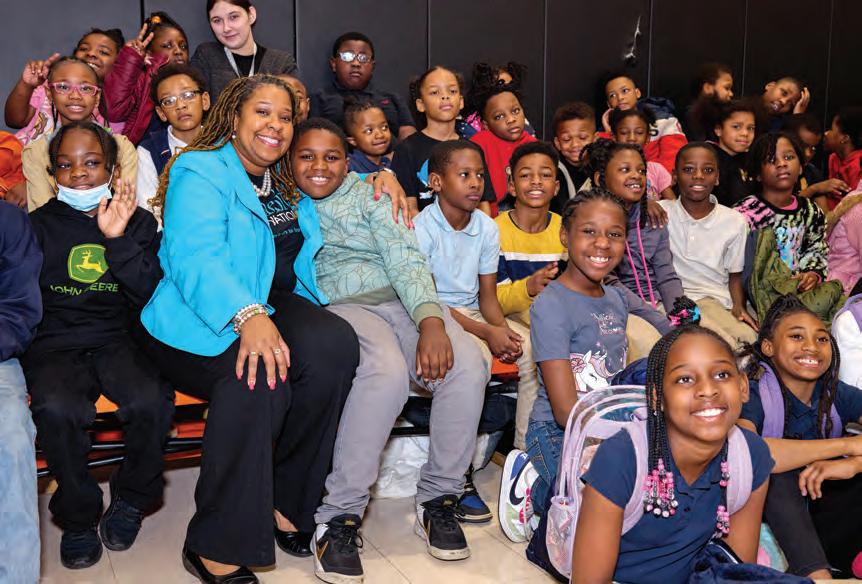
A Little Bit Makes a Big Difference
A part-time job at Mizzou led Miranda Walker Jones to a Super Bowl ring and a life dedicated to community service. “I worked closely with the football team through my job in the athletics dining hall,” says Jones, BA ’97. “The relationships I built helped me land a community and public relations job with the St. Louis Rams my senior year. I loved bringing Rams players out to work in the community. It was also pretty cool to earn a Super Bowl Ring when they won in 2000!”
Jones spent the next two decades working with nonprofits to stabilize inner-city neighborhoods in St. Louis and serving on the Board of Education in Jennings, Mo. She also got into politics, first as a councilwoman for Jennings and then as district director of Missouri’s 1st Congressional District. However, she quickly realized she didn’t like all the bureaucracy and wanted more of a boots-on-the ground role. When the CEO position at the Little Bit Foundation opened up, Jones felt it was the perfect fit.
The Little Bit Foundation focuses on breaking down barriers to educational equity for St. Louis-area students living in poverty by providing them with what they need to stay in school and succeed. “It’s hard to concentrate in the classroom if you’re hungry,” Jones says. “If you’re missing school because it’s cold and you don’t have a coat, you’re not getting the educa-
tion needed to break the cycle of poverty.”

Giving Day Gets Big Numbers
In a stellar showcase of philanthropy and community spirit, the University of Missouri recently concluded its seventh annual Mizzou Giving Day. Spanning a 24-hour period starting on March 13, the event rallied alumni from around the globe to contribute towards the university’s mission of excellence in education and research. By the numbers, Giving Day resulted in:
2,175 gifts
with some of the 14,000 students that the organization serves by providing clothing, shoes, hygiene kits, dental supplies, food and other school essentials.
Little Bit currently serves 14,000 students in 48 schools (56 by the end of 2024). The organization stocks a boutique in each school with essentials, including clothing, shoes, hygiene kits, dental supplies and food. It also holds an annual winter coat drive and offers health screenings, literacy programs, STEM curriculum, and college and career planning to its students. This year, Little Bit hired case managers to work with families on immediate needs such as food security, mental and physical health, transportation, clothing, toiletries, rent and utilities. The overall goal? To find solutions to the systemic problems of poverty. Jones credits Mizzou for helping her break her own cycle of poverty. “I’m from East St. Louis, a very under-resourced community,” she says. “Thanks to my village of support at Mizzou and my campus involvement, especially with the Legion of Black Collegians, I was able to succeed. My experience at Mizzou served as my training ground for helping others break that poverty cycle, too.” — Blaire Leible Garwitz, MA ’06
Generous donations poured in during Mizzou Giving Day, a confirmation of donors’ strong commitment to the university’s advancement.
$12,710,667 raised:
The collective impact of donations resulted in a substantial sum that will fuel vital programs and initiatives across the university campus.
A special shout-out is owed to the nearly 100 ambassadors for the event. These dedicated volunteers leveraged their networks to amplify the reach of Giving Day and inspire further contributions.
50 MIZZOUMAGAZINE MIZZOU ALUMNI NEWS COURTESY OF MIRANDA WALKER JONES H MIZZOU ALUMNI ASSOCIATION ANNUAL MEMBER | HH LIFE MEMBER
Little Bit Foundation CEO Miranda Walker Jones, BA ’97, poses



Whether you're an employer looking to strengthen your workforce or an individual looking to advance in your career, the MU Career Accelerator is here to meet your needs.
BUILT FOR YOUR NEEDS
• Self-paced or synchronous options
• Online or in-person options
• Continuing education hours available
• Industry-specific training courses
• Bootcamps
• Certifications
• Invest in your employees with our customized plans

51 SPRING 2024
GAIN NEW SKILLS
GET
EMPLOYEES
STARTED mizzou.us/careeraccelerator careeraccelerator@missouri.edu MU CAREER ACCELERATOR INDUSTRY-DRIVEN EDUCATION FOR MISSOURI'S
CUSTOMIZED WORKFORCE TRAINING
MIZZOU ALUMNI NEWS

DOUG GEED SIGNS OFF
A toast to an award-winning journalist and Long Island staple.
When Doug Geed, BJ ’80, retired from the 24-hour cable station News 12 Long Island in December, Newsday dubbed him “one of the most recognizable faces on Long Island.’’ It’s easy to see why.
The longtime anchor and reporter won 10 New York Emmy Awards and a Long Island Journalist of the Year award; was inducted into the Long Island Journalism Hall of Fame; and created and hosted the popular East End Show, where until his retirement he highlighted stories of commercial fishermen and farmers in that colorful region of Long Island.
“What I am most proud of is that I played a significant role in the success of News 12,’’ says Geed, who was with the station when it launched. “A 24-hour TV station of just local news was a big experiment in 1986, but we became beloved.’’
Geed also is proud of his family’s ties to the university. His father, Henry, graduated from Mizzou in 1943 before serving on fighter planes during World War II. Before he went overseas, his bride-to-be, Lucille, took a train from New York to make it official in Missouri. They were married at Calvary Episcopal Church and enjoyed their honeymoon at the Tiger Hotel.
They took a trip back to Missouri for their 30th anniversary. Then a freshman in high school, Geed had heard about Mizzou’s J-School. “I flew out midway through their trip, fell in love with the campus, and knew I wanted to go to school there.’’

“I thank God every day for my connection with Columbia,’’ says Doug Geed, who recently retired from 24-hour cable station News 12 Long Island.
Years later, another Geed fell in love with Columbia. Geed’s daughter, Kierin Geed, BS BGS ’17, became the third generation to graduate from Mizzou.
“I thank God every day for my connection with Columbia,’’ the elder Geed says. “It wasn’t just being able to attend the best journalism school in the world and the experience of working at KBIA and KOMU, but the personal connections, as well. My mom and dad began their life together 80 years ago, just blocks from the J-School. My daughter lived at Mark Twain her freshman year, and her room overlooked the marquee of the Tiger Hotel.”
Like many before him, Geed credits his success to the training he received at the J-School, especially through the Missouri Method.
“It instilled in me the importance of keeping integrity in the journalism profession,’’ he says. “Honesty, fairness, an open but skeptical mind — all of that needs to be at the heart of any journalist.’’
— Kevin Mattimore, BJ ’83
2000
R.L. Nave, BA ’00, of Birmingham, Ala., was named a Sulzberger Executive Leadership Program fellow at Columbia Journalism School for the 2024–25 academic year.
Damian Paletta, BJ ’02, of Washington, D.C., is Washington coverage chief for The Wall Street Journal.
Adam Stoverink, BS BA ’04, of Fayetteville, Ark., wrote Unbreakable: Building and Leading Resilient Teams (Stanford Business Books, 2023).
Laura Theissen, BA ’04, of Columbia, Mo., wrote Cuthbert: The Eagle Who Found His Wings (Christian Faith Publishing, 2023).
Cameron Duff, MA ’05, of Parkman, Wy., is administrative director of Sheridan County, Wyoming.
Briana Sprick Schuster, BA ’07, of Nashville, Tenn., was promoted to counsel at Bass, Berry & Sims.
HHRachel Anderson, BGS ’08, of Springfield, Mo., received the 2024 Lieutenant Governor’s Women of Achievement Award from the Office of Missouri Lieutenant Governor.
2010
Bradley Minkow, BJ ’10, of Chicago is chief business officer at Oak Street Health.
Paul Schwinn, BJ ’10, MBA, JD ’14, Potomac, Md., was named to Best Lawyers: Ones to Watch 2024.
Catherine Meagher, BA, BJ ’11, of Columbia, Mo., is activation strategy supervisor for True Media.
52 MIZZOUMAGAZINE
COURTESY DOUG GEED
Support of the Mizzou Traditions Fund enhances student experiences, scholarship funding and hands-on research. By making a gift, you are enriching experiences for every student, while helping create memories for a lifetime.
STUDENT EVENTS AND PROGRAMMING
We support our Tigers even before they leave campus. Our awards, including Mizzou 18 & ’39, highlight our students’ achievements and dedication to their fellow Tigers, while networking opportunities like the Griffiths Leadership Society allow students to immediately begin building lifelong connections with alumni.
SCHOLARSHIP FUNDRAISING
Thanks to member support, we’re able to award over $750,000 annually in merit- and need-based scholarships. To date, the MAA is the largest on-campus provider of scholarship funding.
HALLMARK CAMPUS TRADITIONS
Mizzou has consistently been recognized as having the largest, longest and best Homecoming celebration in the nation — a tradition maintained through our support. The MAA is also responsible for the creation and preservation of new, beloved traditions, including Tiger Walk & Senior Sendoff.

53 SPRING 2024 Mizzou.us/TraditionsFund SCAN TO GIVE NOW:


When Giving Becomes a Family Affair

“B” and Peggy shared their love of their alma mater with all six of their children. For Christmas one year, many decades ago, the children chipped in for something special: a scholarship in their parents’ name.
Since their parents’ passing, the Bearman siblings have continued to hear from recipients of the Bernard L. and Peggy K. Bearman Scholarship — even getting to meet some, on occasion. And thanks to additional investments through a sibling’s charitable gift annuity, the scholarship fund has continued to grow.
It’s a family tradition that’s even better with age. “B” and Peggy would be proud.

Charitable gift annuities support the causes you love while providing dependable income in your retirement years. Contact the Office of Gift Planning at 573-882-0272 or giftplanning@missouri.edu to learn more.
Dani Wexelman, BJ ’11, of New York, is cohost of Spring Breakout Squeeze Play on ESPN+.
Tina Balser, M Ed ’12, Ed D ’18, of Columbia, Mo., is director, technology account management at EAB.
Natasha Mistry, BA, BSBA ’12, of Kansas City, Mo., was named to Consulting Magazine’s 2024 Rising Stars.
Nicole Evans, MPA ’13, of Washington, D.C., is senior director of development communications for United Way.
Paani Annan, BJ ’14, of Portland, Ore., a brand director at Widen + Kennedy.
HClarissa Cauthorn, BS ’15, of Mexico, Mo., received the G. Andy Runge Ambassador Award
from the Mexico Chamber of Commerce.
HHKatie Deschler Fuller, BS BA ’15, of St. Louis is senior procurement business partner at Nestle Purina North America.
Samantha Giles, BJ ’15, of Tacoma, Wa., is director of data science and customer engagement for Allegiant.
Camille Hosman, BA ’15, of Washington, D.C., is director of federal government affairs at Stanford University.
Kiersten Kuc Randall, BJ ’15, MA ’17, of Chicago is vice president, experience strategy director for McCann Health New York.
Ellie Meyer Boyle, BS BA ’15, of New York is director of event management at Bisnow.
Columbia | East 3100 Interstate 70 Dr SE, Columbia, MO 65201
Columbia | Stadium Boulevard 1000 Knipp Street, Columbia, MO 65203
Rate Code 307840 Our generous, free amenities are designed to help you…
MIZZOU ALUMNI NEWS
John Chalender, BS BA ’16, of Scottsdale, Ariz., is a senior host success manager at Turo.
Colton Kreup, B Acc, M Acc ’16, of St. Louis is chief financial officer at Anew Transport.
Kaylyn Shinault, BHS ’16, MHA ’18, of Saint Charles, Mo., is director of strategy, performance improvement and innovation at Kaiser Permanente.
Sheena Rice, MPA ’17, of Columbia, Mo., is a member of the 2024 Leadership Columbia class with the Columbia Chamber of Commerce.
HHLillie Heigl, BA, BJ ’18, of Washington, D.C., co-authored the academic paper Pennies on the Dollar: The Use of Subminimum Wage for Disabled Workers Across the United States.

HHCady Lowery, BJ ’18, of Chicago is a senior account executive for Intersport.
Sarah Sabatke, BJ ’18, MA ’20, of Columbia, Md., is senior associate strategic communications specialist for Lafayette Group.
Jennifer Fowler, BJ ’19, of Chicago is employee communications specialist, global field communications at Expedia Group.
Jamila St. Ann, MA ’19, of Kansas City, Mo., is social media manager for the United States Women’s National Team.
2020
Aaron Carter, BA, BJ ’20, of Chicago is director, corporate reputation at FTI Consulting.
Danielle Gee, BJ ’21, of
Los Angeles is a college sports digital editor at ESPN.
HHElizabeth Dorssom, PhD ’22, of Jefferson City, Mo., wrote Missouri Politics: Government in the Show Me State (Kendall/Hunt Publishing Company, 2024).
Lexi Eskijian, BJ ’22, of Minneapolis is a customer account specialist with General Mills.
HHNoah Klein, BJ ’22, of Raleigh, N.C., won a Midsouth Regional Emmy for Public Affairs Program.
Lauren Purdy, BJ ’22, of Baltimore is digital web coordinator for the Baltimore Ravens.
Nash Walker, BJ ’22, of Reno, Nev., is a content creator and broadcaster for the Reno Aces.

55 SPRING 2024
DRURYHOTELS.COM ◆ 800-DRURYINN
Discount
Use
◆
Hot Breakfast ◆ Free Hot Food & Cold Drinks
Kickback® ◆ Free Wi-Fi
Rates Available!
Free
at5:30
MIZZOU ALUMNI NEWS
HBrandon Antony, BJ ’23, of Minneapolis the sports director and morning show host at KATE Radio.
Drew Felman, BS ’23, of Chicago is an inside sales representative for the Chicago White Sox.
Jefferson Sossamon, MA ’23, of Columbia, Mo., is senior market communications manager at Prytime Medical Devices, Inc.
Births
HHSara Bondioli, BJ, BA ’05 and Erich Streckfuss of Cincinnati announce the birth of Cecilia Sharon Streckfuss Oct. 6, 2023.
Shawn Davis, BS ’08, and Megan Noe Davis, BA, BJ ’12, of Columbia, Mo., announce the birth of Henry Robert Dec. 7, 2023.
Rae Griffin BHS ’13, and Jordon Griffin and of Albia,
Iowa announce the birth of Spencer Michael Griffin Jan. 24, 2024.
Weddings
HHJeff Zumsteg, BES ’84, MBA ’86, and HHJeff Linville, BS ’92, of Kansas City, Mo., July 15, 2023.
HMathew McWilliams, BS BA’12, and Martha Watts of Chicago Sept. 15, 2023.
HHMelanie Pancoast, BS ’16, MD ’20, and Elliott Voss, BS ’16, MD ’20, of Winston-Salem, N.C., Feb. 24, 2024.
HHMorgan Kopitsky, BJ ’18, MPA ’21, and James Hackney, BS ’18, of Columbia, Mo., Jan. 13, 2024.
Faculty Deaths
Laura Thurman, BS HE ’81, MS ’92, of Columbia, Mo., Aug. 20, 2023, at 64. She taught at MU for 15 years.
Deaths
HRobert W. Keith, BS BA ’47, of Greenport, N.Y., Jan. 28, 2024, at 97. He was a member of Beta Theta Pi.
HBilly Claybourn, BS ChE ’48, of Fort Worth, Texas Sept. 23, 2023, at 97. He served in the U.S. Army.
Barbara J. Grubb, BS Ed ’52, of Pheonix Jan. 1, 2024, at 92. She was a member of Delta Gamma.
HGeorge Satterlee, Jr., BS CiE ’52, of Leawood, Kan., Aug. 23, 2023, at 92. He was a member of Sigma Chi and served in the U.S. Army.
HHClifford H. Brown, Jr., BS ChE ’53, of Seabrook, Texas, Nov. 7, 2023, at 92. He served in the U.S. Air Force.
HHJane E. McQuie, BS Ed ’53, of Montgomery City, Mo., Jan. 1, 2024, at 92. She was a member of Kappa Delta and the first woman elected as an alderman in Montgomery City.
HHHarold Westhues, BS BA ’53, of Jefferson City, Mo., Aug. 26, 2023, 92. He served in the U.S. Army.
Earl Garber, BA ’54, of Peabody, Mass., Aug. 7, 2023, at 92. He was a member of Alpha Epsilon Pi and served in the of the U.S. Army.
Nancy S. Buchanan, BS HE ’55, of Ashburn, Va., Feb. 8, 2024, at 90. She was a member of Pi Beta Phi.
HHGrace Taylor Eubanks, BJ ’55, of University Place, Wash., Nov. 17, 2023, at 90.
James F. Thiel, BS Ag ’55, of Tipton, Mo., July 27, 2023, at 92. He served in the U.S. Air Force.
HHJohn Harold McComb, BS ME ’56, of Fox Lake, Ill., Nov. 11, 2023, at 90. He served in the U.S. Navy.
HHDarrell E. Melton, BS ME ’56, of Springfield, Mo., Nov. 15, 2023, at 90. He worked for NASA for 25 years.
HHDean Pence Proffitt, BS Ag ’56, of West Plains, Mo., Jan. 8, 2024, at 89. He was a member of Farmhouse.
HAnn Dilworth Rich, BJ ’57, of Independence, Mo., Dec. 22, 2023, at 89.
HHMarilyn Glasgow Legan, BS Ed ’57, of Dyersburg, Tenn., Dec. 28, 2023, at 90. She was a member of Alpha Delta Pi.












56 MIZZOUMAGAZINE
H MIZZOU ALUMNI ASSOCIATION ANNUAL MEMBER | HH LIFE MEMBER Contact your local FNC Real Estate and Land Management Professionals for a confidential consultation today! Call 316-400-5460 www.FarmersNational.com Real Estate Sales • Farm and Ranch Management • Energy Management Appraisals • Insurance • Consultations • Forestry Management • Hunting Lease Network • FNC Ag Stock Daniel Roling Agent Armstrong, Missouri Ryan Sadler AFM/Agent Maryville, Missouri Ken Springer Agent Lee’s Summit, Missouri Keith Tucker AFM/Agent Baldwin City, Kansas Howard Audsley Agent Columbia, Missouri Greg Knedlik Agent Paola, Kansas Jordan Olsen Agent Baldwin City, Kansas David Peck Agent Kingdom City, Missouri Enhance Your Family Legacy with the Expertise of Farmers National Company Mandy Quinn AFM/Agent Shawnee, Kansas Lucas Robinson AFM/Agent Columbia, Missouri Matt Robinson Agent Vandalia, Missouri
HHKent Kreh, BA ’57, DHL ’98, of St. Louis Jan. 19, 2024, at 88. He was a member of Sigma Phi Epsilon and served in the U.S. Army.
William Marsh, BS Ag ’57, of Independence, Mo., Jan. 19, 2024, at 94. He served in the U.S. Army. He was a teacher for over 35 years.
HJulia “Betty” Sisson, BS Ed ’57, of Columbia, Mo., Dec. 2, 2023, at 88.
HSally Baumeier-Stevens, BSN ’59, of Poland, Ohio,
Nov. 22, 2023, at 91.
HRobert S. Bricker, BS Ag ’59, of Pleasant Hill, Mo., Dec. 31, 2023, at 89.
HHMorgan Dean Pope, BS ’59, of Portland, Ore., Nov. 3, 2023, at 86. He was a member of Kappa Alpha Order.
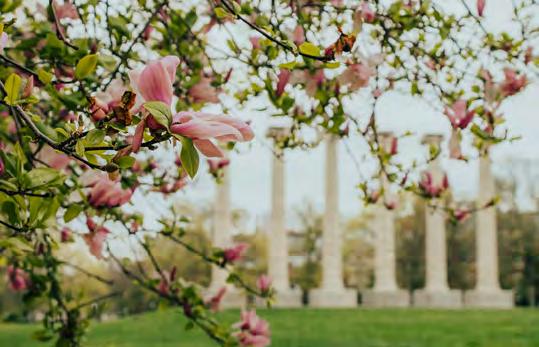

$25 for 25 years! Make a gift today to support programming for Mizzou Botanic Garden’s 25th
Our newly transplanted white oaks have a natural lifespan of over 200 years, and have been growing on MU’s South Farm for 6 years in preparation for their transplantation to our Francis Quadrangle.


garden.missouri.edu
You don’t need to create a clever plate to support Mizzou — the state can now issue a randomized set of letters and numbers for your new plate. Just follow the instructions on our website under FAQs and ‘standard-issue license plate.’

57 SPRING 2024 Represent Mizzou on the road with a collegiate license plate. Non-personalized Mizzou plates are now available!
THIS IS COUNTRY! Mizzou.com/Plates G7V 8WY
SCAN TO GIVE
ensure our campus remains beautiful for decades to come. MIZZOUGIVEDIRECT.MISSOURI.EDU/SUPPORT-LEGACYOAKS 573-882-4240
Make a gift today to support the Legacy Oaks project, and
Established Aug. 26, 1999, Mizzou Botanic Garden is the entirety of the 1,252-acre campus, with 19 specialty gardens and three tree trails.
Pin oaks are one of the most short-lived oak species; with a lifespan of 70-90 years, Mizzou’s original trees were considered end-of-life.
MIZZOU ALUMNI NEWS
REMEMBERING

MICROPHONE MAESTRO
It had been 33 years since Larry Zimmer earned his degree a few blocks away at the Missouri School of Journalism, and fewer since launching his professional career up Providence Road calling Hickman High School games.
But when Zimmer, BJ ’57, hunkered over the microphone on Oct. 6, 1990, at Faurot Field — now narrating Colorado Buffaloes football for KOA-Denver — it was to be his audience’s most memorable moment in Columbia.
The controversial Fifth-Down Game, when referees lost track of the downs allowing the eventual NCAA champion Buffs an extra play as time expired to defeat the Tigers 33-31, haunts many Mizzou fans to this day.
“You’re never going to have an incident like the ‘Fifth Down’ today because they would go back and review it,” Zimmer told SB Nation in 2015. “One of the great stories, and we’re still talking about it 25 years later.”
Zimmer died at age 88, Jan. 20, 2024, in Lakewood, Colorado. In addition to 486 football games with CU, he worked 536 preseason, regular-season and postseason games with the NFL’s Denver Broncos — including four Super Bowls.
“Larry was a very proud Mizzou alumnus and truly believed it is the best journalism school in the country,” says Brigitte Zimmer,
his wife of 51 years. “Some of his fondest memories were of working with [Missouri broadcasting pioneer] Mahlon Aldridge at KFRU.”
Zimmer was born Nov. 13, 1935, in New Orleans. He attended Louisiana State University before transferring to Mizzou, graduating and serving two years of active duty in the U.S. Army.
Known for his keen storytelling style and the charming intimacy with which he conveyed live action, Zimmer also taught broadcasting courses at the University of Colorado.
“In truth, you are being invited into a person’s living room,” said Zimmer, describing his discipline to MIZZOU in 2009. “You’re really only talking to one person or two people in a very intimate medium.”
Zimmer’s indelible audio legacy lives on for millions of Colorado sports fans, but his voice was especially poignant for his granddaughter, Shannon Robb, who followed in his footsteps at Mizzou.
“He had such an amazing curiosity, and he was such a people person, always getting people to tell their stories,” says Robb, BA, BJ ’15, now a communications manager at the Denver Art Museum. “It’s easy to look at sports as a game, or a collection of statistics, without a story. My grandpa made every single game a story.” — Marcus Wilkins, BA ’03
Events
April 26–27, Donor Recognition Weekend
May 4, Trizou Triathlon, Stankowski Field
10, Local Natives The Blue Note
7–11, SEC Softball Tournament, Jane B. Moore Field, Auburn, Alabama
10-12, University of Missouri Commencement Ceremonies, MU Campus
11, Stronger Than Fiction Film Festival, Missouri Theatre
25–26, Peddler’s Jamboree Bicycle and Music Festival Various locations starting at Flat Branch Park
June 4, Mizzou Summer Repertory Theater presents Comedies in Concert
McKee Gymnasium, Studio 4
7, Odyssey Chamber Music Series presents The Schumann Play First Baptist Church, Columbia
22, Missouri Symphony’s Firefly Music Festival
Jesse Hall Rotunda, through July 13
26, Mizzou Night with the St. Louis Cardinals Busch Stadium
58 MIZZOUMAGAZINE
ILLUSTRATION: BLAKE DINSDALE


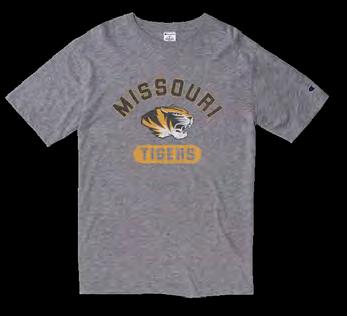

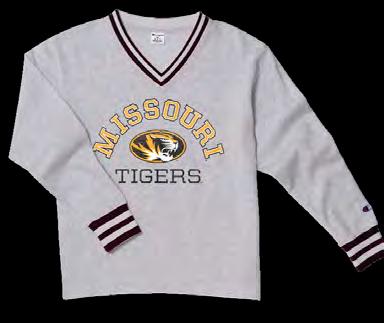



59 SPRING 2024 Build your MIZZOU. The first-ever officially licensed Mizzou Columns building kit. Buy Here: $49.99 + $5.99 Shipping Available in store SPRING FORWARD IN STYLE! Rep your Mizzou pride this spring with brand new Missouri Tigers apparel, now available at Sam’s Club! From warm days on the pickleball court to chilly evenings by the lake, these fun and versatile pieces will have you covered. Ladies’ Layer Up Fleece Men’s On The Court Crew Tee Spring
Crew
Front Pocket
Has Sprung
Tee


MU Health Care’s Children’s Hospital
Opening June 2024
Every aspect of our new Children’s Hospital is designed to make a vulnerable time more comforting. From private patient rooms and welcoming environments to spaces for children to play, we’re building a place that puts our kids first.
Nature is one of the key visually comforting themes chosen for our patients, including a display of Missouri’s state bird — the Eastern bluebird — in the canopy of a two-story tree in the main lobby. These bluebirds serve as a reminder of the flock of support donors provide mid-Missouri children and families in their time of need.
Scan to Give
Each bluebird in the lobby of the new Children’s Hospital represents a donor’s generosity. To learn more about becoming a Bluebird supporter, visit Mizzou.us/MUCHBluebird or call (573) 884-3672.
Support the future of health care.

REMEMBERING
Donlin M. Long, Legendary Neurosurgeon MIZZOU ALUMNI
Donlin M. Long (BA ’55, MD ’59), a worldrenowned brain surgeon, brought a smalltown Missouri sensibility along with a masterful skill to the operating room and the halls of academia. Friendly, warm and sincere, he was just as likely to describe a difficult situation as “hard cheese” as to expound on the intricacies involved in successful surgery.
Neurosurgeon, mentor, teacher, innovator, outdoorsman and opera lover — Long, who died this past fall at 89, was all those and more. After graduating from the MU School of Medicine, Long began a trail-blazing career that advanced — some would say revolutionized — the practice of neurosurgery and helped develop a medical device that saved millions of people throughout the world from a lifetime of intractable suffering.
Long was born in Rolla and raised in Jefferson City, leaving Missouri to earn a PhD in neuroanatomy at the University of Minnesota before becoming the founding chair of the Neurosurgery Department of Johns Hopkins University School of Medicine, a position he held for 27 years. As a role model, he inspired several generations of neurosurgeons.
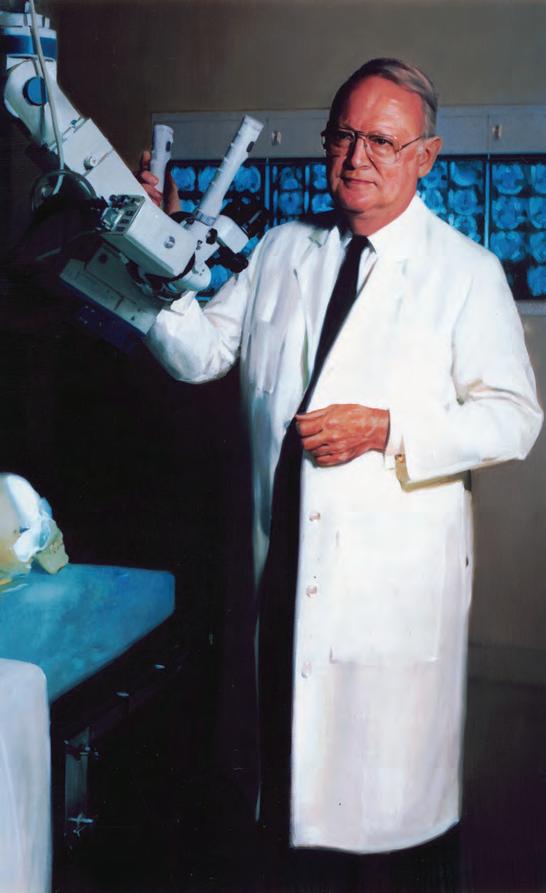
HSteven Bursten, BS BA ’60, of Rockville, Md., July 23, 2023, at 86. He served in the U.S. Air Force.
HHWilliam Hopkins, MD ’61, of Kansas City, Mo., Jan. 17, 2024, at 90. He served in the U.S. Army.
Rheta C. Hubenthal, BA ’61, of Harrisville, Pa., Jan. 22, 2024, at 84.
HHSharon Keister, BA ’61, of Coon Rapids, Minn., Dec. 16, 2023, at 84. She was a member of Alpha Delta Pi.
HOrien E. McDaniel, Jr., BJ ’61, of Northport, N.Y., Dec. 26, 2023, at 84. He served in the U.S. Army.
HHFerdinand Del Pizzo, Jr., MD ’62, of Chesterfield, Mo., Nov. 10, 2023, at 87. He was a member of Beta Theta Pi and served in the U.S. Army.
Geoffrey Payne, BS EE ’62, of Rutherford, Tenn., July 30, 2023, at 86.
HBenjamin C. Patch, Jr., MA ’62, of Gering, Neb., Nov. 15, 2023, at 92. He served in the U.S. Navy.
HHWilliam S. Thomas, BS CiE ’62, of Amarillo, Texas, Nov. 13, 2023, at 84. He was a member of Kappa Alpha Order.
Medical students, residents and colleagues valued Long’s calm, steady leadership and his can-do attitude. He was best known in the medical world for his role in developing in 1981 the first external transcutaneous electrical stimulator (TENS), now prescribed throughout the world to ease pain from a variety of conditions. He also participated in
the development of an implantable medical pump to administer insulin to patients with diabetes. His research on the blood-brain barrier led to the standardized use of steroids to treat brain edema in neurosurgery. Long never lost his zest for improving the practice of neurosurgery and the education of new surgeons. After retiring from Johns Hopkins, he presented a lecture at the MU School of Medicine, where he advocated for competency-based education, with a goal of enabling others to achieve excellence in their careers, as he had done.
— Jack Wax, BS Ed ’73, MS ’76, MA ’87
HRichard Angell, BA ’63, of Batavia, Ill., Feb. 24, 20224, at 82. He served in the U.S. Air Force and was an orthopedic surgeon for over 30 years.
HHJeanette Rauh Dollus, BS Ed ’63, of Ballwin, Mo., Dec. 17, 2023, at 83.
HHLaRoy Garrison, Jr., BS BA ’64, of Macon, Mo., Nov. 17, 2023, at 86. He was an accountant for 50 years.
61 SPRING 2024
JOHNS HOPKINS CHESNEY MEDICAL ARCHIVES
NEWS
MIZZOU ALUMNI NEWS
Raymond Eugene Boothe, BS Ag ’65, of Eagleville, Mo., Jan. 5, 2022, at 78.
HHMaxine V. Mosley, MA ’65, of Kirksville, Mo., Dec. 10, 2023, at 95.
HGary A. Spragg, BS Ag ’65, DVM ’67, of Rogersville, Mo., Jan. 27, 2024, at 80. He served in the U.S. Army.
HKenneth Wagner, BS Ed ’65, M Ed ’66, of St. Louis Aug. 7, 2023, at 81. He served in the U.S. Army.
Richard Benkof, BA ’66, of St. Louis Jan. 13, 2024, at 79.
HH. Roger Grant, MA ’67, PhD ’70, of Albia, Iowa, Nov. 17, 2023 at 79. He authored over 30 academic books.
Thomas J. Griffiths, BJ ’67, of Hendersonville,
Tenn., Jan. 15, 2024, at 78. He served in the U.S. Navy.
HHJacqueline D. Krafft, BS Ed ’67, of Washington, Mo., Nov. 7, 2023, at 86. She taught kindergarten for 25 years.
HHMary Sloan, BJ ’67, of Columbia, Mo., Nov. 19, 2023, at 79.
Stephen S. Brown, BS BA ’68, of Kansas City, Mo., Sept. 3, 2022, at 76. He was a member of Sigma Phi Epsilon.
HHA. Paul DeMargel, Jr., BJ ’68, of Chesterfield, Mo., Dec. 31, 2023, at 77. He served in the U.S. Army.
Mary Jane Moorman, BS Ed ’68, of Springfield, Ill., Oct. 3, 2023, at 74. She was a member of Alpha Phi.
MEET COLUMBIA
THROUGH THE EYES OF MO LOUIS
RADIO DJ, 102.3 BXR, DISC GOLF ENTHUSIAST
Mo Louis is a man of many scenes — music, disc golf, social, culinary, microbrew — and for him, Columbia checks off all the right boxes. Whether it’s catching a live show at Rose Music Hall or trying to beat the world-renowned disc golf course at Harmony Bends, there’s a good chance you’ll find Mo making the most of his Columbia any day of the week. See his story and others at MeetCOMO.com
HHBarbara Hiatte, BS Ed ’69, of Jefferson City, Mo., Jan. 23, 2024, at 91. She was an English teacher and librarian.
HHDonna Moog, BS HE ’69, of Tempe, Ariz., Nov. 4, 2023, at 77.
Charles R. Devore, BS Ed ’70, M Ed ’76, of Columbia, Mo., Jan. 30, 2024, at 79.
HLawrence Haney, BS Ed ’70, MA ’71, of Butler, Mo., Sept. 29, 2023, at 75. He was a member of Marching Mizzou.
Larry Riley, M Ed ’70, PhD ’71, of Maryville, Mo., Jan. 16, 2024, at 78. He was a professor of psychology at Northwest Missouri State University for 37 years.
HHPaul George Ruff, MD ’70, of Springfield, Mo., Oct. 29, 2023, at 79.
HHMichael R. Burkeybile, BS Ag ’72, of Macon, Mo., Nov. 5, 2023, at 73.
HLyndal C. Grieb, MA ’72, of Keller, Texas Nov. 2, 2023, at 83.
Marcia Schlotman, BSN ’72, of Oak Grove, Mo., Feb. 17, 2024, at 73. She served in the U.S. Air Force.
Cathryn Barron, BS Ed ’74, of Chesterfield, Mo., Jan. 16, 2024, at 72.
Wendy Novak, BJ ’74, of Louisville, Ken., Feb. 24, 2024, at 71. She was a member of Chi Omega.
Cherie Aird, BA ’75, MSW ’84, of Moberly, Mo., Jan. 14, 2024, at 79.
HDiana Cleary, BS HE ’75, of Merritt Island, Fla., Oct. 31, 2023, at 74.
Jan Landrum, M Ed ’75, of St. Louis Jan. 20, 2024, at 92. She taught home economics for 22 years.
HHBeverly Richtermeyer, M Ed ’75, of Jefferson City, Mo., Dec. 7, 2023, at 91.
HMichael Eugene Foshee, BS CiE ’76, of Wayne, Okla., Nov. 3, 2023, at 75.
Steven Alan Simon, MBA ’78, of California, Mo., Nov. 28, 2023, at 69.
HKaren Ball, BJ ’84, of Mission Hills, Kan., Nov. 24, 2023, at 62.
Jesse Oscar Anthony III, MA ’85, of Nokomis, Fla., March 3, 2023, at 78.
HHLora Plattner, BA ’85, MD ’91, of Scottsdale, Ariz., Dec. 16, 2023, at 61.
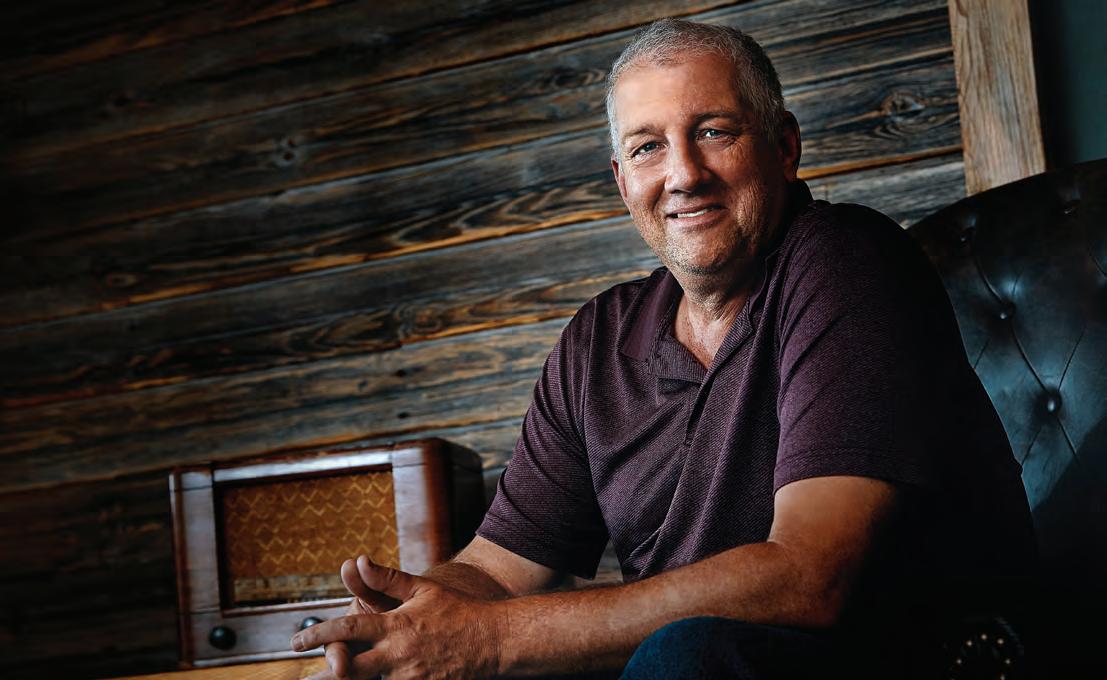
62 MIZZOUMAGAZINE
H MIZZOU ALUMNI ASSOCIATION ANNUAL MEMBER | HH LIFE MEMBER
buy aflac .com
ADVERTISING INDEX
Mizzou Advancement 15, 54 giving missouri edu
Mizzou Alumni Association 14, 42–45, 53, 57 mizzou com
Mizzou MBA
Mizzou Store
MU Botanic Garden
gardens missouri edu
MU Career Accelerator
mizzou us/careeraccelerator
MU Health Care
49
60 muhealth org
Parker’s Brick Builds .
parkersbrickbuilds .com
To advertise in MIZZOU, call MAA at 573-882-6611
59
HRichard Bateman, BS CiE ’86, of Raymore, Mo., Nov. 10, 2023, at 80. He served in the U.S. Army.
HHLinda S. Claycomb, BSN ’91, MS ’94, of Linn, Mo., Nov. 10, 2023, at 75.
HHThomas Mitchell, BGS ’14, of Jefferson City, Mo., Nov. 25, 2023, at 67. He served in the U.S. Air Force.



Bachelor’s degrees:
BS Acc, accounting
BS Ag, agriculture
BA, arts
BS BA, business administration
BS Ed, education
BFA, fine arts
BS FW, fisheries and wildlife
BGS, general studies
BHS, health sciences
BS HE, home economics
BS HES, human environmental sciences
BJ, journalism
BS Med, medicine
BSN, nursing
BS, science
BSW, social work

Bachelor’s degrees in engineering:
BS ChE, chemical
BS CiE, civil
BS CoE, computer
BS EE, electrical
BS IE, industrial
BS ME, mechanical
Master’s degrees:
M Acc, accounting
MS Ag Ed, agricultural education
MA, arts
M Ed, education
MS, science
MSW, social work
MPA, public affairs
Doctoral degrees:
PhD, doctorate
EdD, education
JD, law
MD, medicine
DVM, veterinary medicine
Did not graduate:
Arts, arts and science
Bus, business
Educ, education
Engr, engineering
Journ, journalism
HFor a more detailed list of current degrees, visit catalog.missouri.edu/ degreesanddegreeprograms.






63 SPRING 2024 Active
Fit Direct . . . . . . . . . . . . . . . . . . . . . 63 activeandfitdirect
Aflac . . . . . . . . . . . . . . . . . . . . . . . . . . . . C-3
&
com
. . . . . . . . . . . . . . . . . . . . . . . . . . 59
Convention and Visitors Bureau 62 meetCOMO
Hotels 55 druryhotels
Farmers National Company 56 farmersnational .com Missouri Soybeans 2 MOSOY org
Champion
champion .com Columbia
com Drury
.com
. . . . . . . . . . . . . . . . . . . . . . . C-4
business missouri edu
. . . . . . . . . . . . . . . . . . . . . . . . 41
themizzoustore com
. . . . . . . . . . . . . . . . . . . . . 57
. . . . . . . . . . . . . . . .
. .
. . . . . . . . . . . . . . . . . . . .
.
. . . . . . . . . . . . . . . . . . .
More Fitness Network Standard 1 Add a spouse/domestic partner to a primary membership for additional monthly fees. Spouses/domestic partners must be 18 years or older. Fees may vary based on fitness center selection. 3 Monthly fees are subject to applicable taxes. M966-789C-MZAA 3/24 © 2024 American Specialty Health Incorporated (ASH). All rights reserved. The Active&Fit Direct™ program is provided by American Specialty Health Fitness, Inc., a subsidiary of ASH. Active&Fit Direct and the Active&Fit Direct logos are trademarks of ASH. Other names or logos may be trademarks of their respective owners. Standard gym and premium studio participation varies by location and is subject to change. On-demand workout videos are subject to change. ASH reserves the right to modify any aspect of the Program (including, without limitation, the Enrollment Fee(s), the Monthly Fee(s), any future Annual Maintenance Fees, and/or the Introductory Period) at any time per the terms and conditions. If we modify a fee or make a material change to the Program, we will provide you with no less than 30 days’ notice prior to the effective date of the change. We may discontinue the Program at any time upon advance written notice. Fitness
Affordable Get Started: Please access the registration/enrollment link on the Alumni Member Discount page or scan the QR code. Find your perfect gym from 12,500+ options nationwide. 1 Enroll online in minutes, with no long-term contracts or annual fees. 2 Start working out today! Your membership also includes 1:1 well-being coaching and the option to purchase a membership for your spouse.1 3 S TANDARDFITN E SS MEMBERSH I P $28/mo. 12,500+ FITNESS CENTERS 2 DEGREE DESIGNATIONS 101 H
Made Easy
SEMPER MIZZOU

The Platinum Season of Diamond Gold
Celebrating 70 years since Tiger baseball — and a young Norm Stewart — won the College World Series in glistening fashion.
Like the nearby track’s cinders that on windy days wafted onto the diamond at Rollins Road and Maryland Avenue, photos in shades of black, white and gray capture the Tigers racing toward home plate, snaring line drives or hoisting championship plaques.
But unlike the vintage images, John “Hi” Simmons — head coach of the 1954 NCAA Champion Mizzou baseball team — was colorful. In fact, when his effusive pupil and former pitcher, Norm Stewart, honored the late legend at a 2003 event to unveil Simmons’ bust, Stormin’ Norman knew best how to encapsulate his beloved mentor.
“I can’t use the language coach used [during mound visits], so when I say ‘number one,’ think ‘chicken feces,’ two is ‘Lord’s name in vain,’ and three is ‘fatherless dog,’ ” said Stewart, BS Ed ’56, M Ed ’60, MU’s basketball coach for 32 years. “Here’s the story: One, two, three. One, two, three, Norm!”
As blue as Simmons’ vocabulary was, his results were golden. Seventy springs ago in Omaha, Nebraska, the Tigers became the first of only two Mizzou national championship teams (the 1965 indoor track squad is the other) when they defeated Rollins University, a Central Florida private school, to clinch the title. Simmons’ decade of success in the 1950s remains unparalleled in school history. He also led national runner-up teams in 1952 and 1958.
Unfortunately, the conquering champs returned to Columbia
during the summer of 1954 to little fanfare; with the students on break, the town was hardly hopping. First baseman Bob Schoonmaker, BS Acc ’54, left directly from the College World Series for Los Angeles and an appearance with his wife on the TV show Queen for a Day. Other players were itching to get on with their summer vacation, which was significantly shortened by the tournament and victory.
Seventy springs ago in Omaha, Nebraska, the baseball Tigers became the first of only two Mizzou national championship teams (so far).
“I remember several of the guys weren’t on the bus ride back from Omaha,” says Kent Henson, BS BA ’56, a sophomore reserve outfielder at the time. “But the Missouri Highway Patrol met us at the state border and escorted us back to Columbia, which was kind of neat.”
Coach Simmons retired in 1973 with a 481-294-3 career record, 11 conference championships and six College World Series trips. He died Jan. 12, 1995, at 89. Only four living players remain from the 1954 roster: Stewart; Henson; Bert Beckmann, BS Ed ’55, M Ed ’58; and Jack Gabler, BS BA ’58.
The 70th anniversary is traditionally signified with platinum, but the legendary “Hi” was perhaps best known for his gems.
“If you get to first base,” Stewart recalled Simmons advising from the dugout, “take a left.” — Marcus Wilkins, BA ’03
64 MIZZOUMAGAZINE
MIZZOU ATHLETICS


Address change? Update at mizzou.com/update or call 800-372-6822. ELECTRONIC SERVICE REQUESTED 123 Fulton, MO 65251 Take the next step >> trulaskemasters@missouri.edu 573-882-2750 | business.missouri.edu/gpo MS IN BUSINESS 100% online MS IN FINANCE 100% online MASTER OF ACCOUNTANCY 100% online or 100% on campus Graduate degrees offered at the Trulaske College of Business ACCELERATE YOUR NETWORK CROSBY MBA 100% online In today’s competitive business landscape, it is crucial to build strong connections. Pursue a graduate degree at the Trulaske College of Business and unlock a world of new opportunities.



















































 Story by Amanda Doyle, BJ ’94
Story by Amanda Doyle, BJ ’94











































































 STORY BY TONY REHAGEN, BA, BJ ’01
STORY BY TONY REHAGEN, BA, BJ ’01














































































